© Saulius Aliukonis
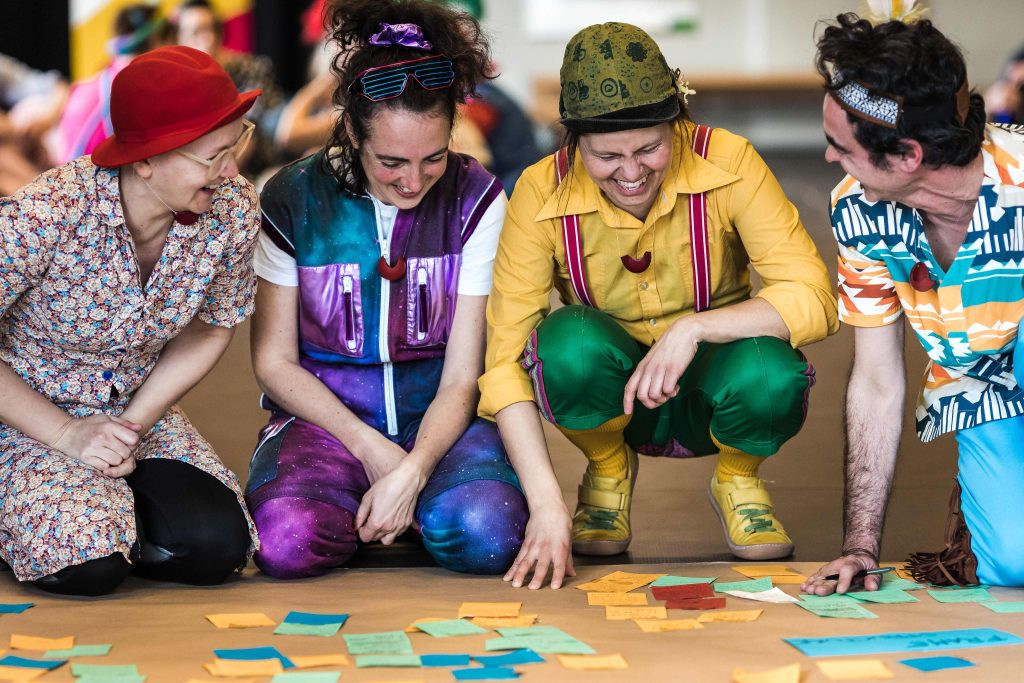
© ROTE NASEN Clowndoctors
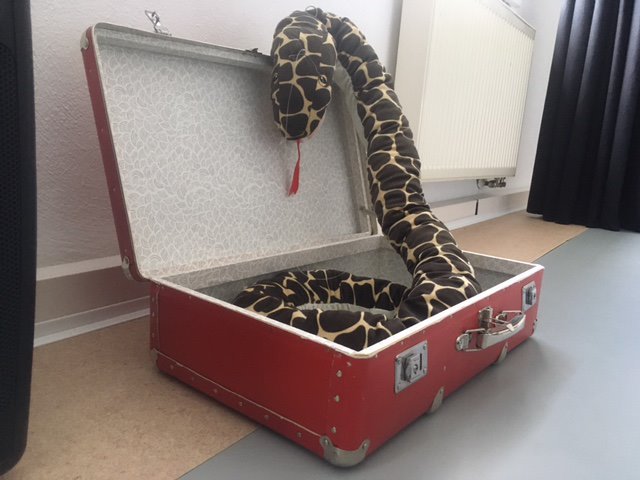
In Austria, some of the participating clowns changed during the course of the ClowNexus project.
However, the research and development approaches were maintained by those who replaced them.
This description of the “tools in practice” focuses on accounts of the artists Christina Matuella, Ingrid Türk-Chlapek and Sara Zambrano.
Christina and Ingrid both have 29 years of clowning experience, having started working with RED NOSES Austria in its first year of operation.
Sara comes from an acting background and has 23 years experience, 7 of which were spent clowning.
The participating artists are part of two different regional teams, in Tyrol and Carinthia.
The ClowNexus visits took place in two long-term care homes specialising in caring for people with dementia in the Carinthia region, namely MaVida Park Velden and Haus Martha in Klagenfurt.
In addition to her role as healthcare clown, Christina is also the Regional Programme Manager for RED NOSES Austria in Tyrol.
Red Noses Austria’s Research and Learning Manager Simone Seebacher, and later Katharina Lessiak, supported the Austria-based artists throughout ClowNexus with research and learning tools.
The duo started their work by researching which homes were best suited for the collaboration. With support from the Research and Learning Manager and guidance from the consultant, who at the beginning of the project developed a Baseline Study, the clowns applied some research tools including observation check-lists and questionnaires to identify the care homes to visit and the residents to work with there.
They visited the same group of seven residents per home, with some alterations due to the homes’ population changes.
Despite coming from different regions of the country, the duo worked together, visiting two long-term care homes in Carinthia.
Once the homes were selected, the artists contacted the two homes to explain the concept.
One of the homes was already being visited by healthcare clowns whereas the other was a new location, and it took some more preparatory exchanges to build the trust and rapport needed for this kind of in-depth cooperation.
The clowns worked with the selected homes for the duration of the project, phasing out visits at the end.
Both of the homes visited by the duos agreed to host a filming crew who were recording footage for the ClowNexus documentary.
Some of the residents and institutional and family carers were interviewed about their experiences.
The homes also accepted visits from the researchers conducting the ClowNexus Final Evaluation Report. This openness also illustrates the rapport and trust built with the institutions and their staff by the artists.
The staff in the homes facilitated access for the clowns to speak with family members of the residents, to identify residents they would work with.
The staff and relatives of participating residents wanted to be part of the process of creating the dynamics for the clown visits.
The clowns worked with them every two months to develop 15-minute interventions. The clowns would then invite the family members to be present during the visits that were based on the co-created scenarios.
The interventions were followed-up by common discussions in a nearby cafe. The duo used a parade as the recurring frame, and the duo would present different topics/scenarios for each visit.
Through the parade, the clowns were also able to engage with other residents in the home, who would see the clowns in the common rooms.
Staff and relatives were also consulted using learning tools.
The artists used an observation checklist for the people observing visits to fill out what they noticed during the visits.
Relatives and staff were also asked to fill out questionnaires. The questionnaires included parameters from the baseline study like observed mood; stress level; attention focus; physical behavior and connection/relationship with the clowns and others present in the room.
From observations about the results of using the questionnaires, the clowns observed that the questionnaires with relatives were more impactful for their work, possibly because the relatives have more of an emotional connection with the residents.
The artists also learned from self-reflection and filling out post-visit forms themselves, the success of the chosen theme and the tools used during a given visit.
This learning tool was further applied with the multipliers (see needs and impact of healthcare clowning organisation below) who the clowns trained and reflected with after each International Artistic Laboratory.
People with dementia – The needs of people to be visited by the clowns were discussed already in pre-selection interviews with family and staff, and further analyzed after performances with institutional and family carers.
In terms of impact, the clowns’ visits and the tools they used were observed to bring back memories, interest people to join organised activities, and engage their senses.
In the scenario described below, the flute and snake dance drew particular attention and excited the participants, including relatives who were happy to see the excitement of their loved ones.
Clowns recalled many people wanting to touch and even kiss the snake in greeting, especially as the snake was connected to a song that incited memories.
Institutional carers had the need to participate in the creative process, engage eager family members and work together with the clowns on the approach of the clown visits.
They also had the need to learn more about how healthcare clowning works, as illustrated by their willingness to fill out observation check-lists and post-visit form questionnaires so the clowns could use this information when planning their subsequent visits.
In terms of impact, the care staff were inspired by the clown visits, which also provided a break in their difficult daily routines.
Family carers have the need for more opportunities to connect with their loved ones, see them cared for and happy, aware of and engaging with their environment.
Through observation and questionnaires and interviews with relatives, the clowns observed that it was touching for them to have these moments together.
For some, seeing their parents physically active and excited brought them to tears, as they hadn’t seen them like this for long periods of time.
From the discussions, the family carers really appreciated the gift of time dedicated to their loved ones.
Clown artists – For the artists, the co-creation that took place in the project, the possibility to engage with the milieu of the persons they visited, and to really research and reflect gave hope, power and appreciation.
Regular meetings between the clowns and the Artistic Lead, help from the RED NOSES International office and the RNA Research and Learning Managers was important in the clown’s journey.
Overall, the clowns shared big learnings from the research being and were glad to have participated.
The greatest gain singled out by one of the participating artists was gaining trust coupled with risk – the risk of really getting involved with everyone from the seniors to their families and staff, and themselves – the clown and person behind the clown – always with the high goal of changing the moment.
Healthcare clowning organisation – RED NOSES Austria had already experienced clowns working with people with dementia, but not so in-depth including the reflection with relatives and staff.
The organisation really embraced the opportunity ClowNexus presented for multiplying learning across the different regions of operation.
After each of the three International Learning Laboratories on working with people with dementia, the participating duo held workshops for RNA’s so-called networkers or multipliers – one clown from each region – to share what they learned, observed and co-created together.
The colleagues would then bring the training knowledge back and bear responsibility for sharing it with their colleagues in the regional teams.
ClowNexus-inspired principles like co-creation, research of artistic tools to use with specific participants, which therefore transpired to the whole of RNA.
Below follows a description of one of several scenarios developed by the duos in Austria.
The artistic tools featured in their work rely a lot on musicality and playing instruments; ukulele, flute, guitar, and singing songs.
The duos also used movement and dance, storytelling, puppetry, creating with objects, using various props including such that engage the senses.
Scenario in Focus: Journey to the Orient
Why interesting: The scenario is both exotic, representing a faraway experience, but also invokes familiar sounds and music. The scenario is a collection of three gifts/surprises by the clowns to the participants – the song “Café oriental”, sand of the desert, and a secret in the suitcase brought by the clowns.
Intention: To invite residents on a sensorial journey filled with gifts and surprises.
Who participates: Seven people with dementia per home, institutional and family carers if present, and, more passively, other residents who are in the living room area or see/hear the clowns entering and leaving with a parade.
Duration: 20 minutes
Setup of the space: The scenario takes place in the living room area of the homes, in a quiet corner of the room. The residents being visited are seated around, other residents are also there, further away from the performance.
Artistic skills needed: Knowledge of the used songs, ability to play ukulele chords, puppetry, duo-clown-play, playing the flute
Props: Letter, a snake in a suitcase, two flutes, a bucket full of sand, a ukulele.
Description: The journey starts with the clowns, suitcase in hand, entering with a parade and a song – “Café Oriental”.
The clowns then greet everyone in the audience, introducing the topic.
The clowns would then proceed to share the gifts they brought to simulate the desert experience.
Knowing that harmony is an important part of the visit, since the visitor does not have to decide who to look at, this visit also had a part dedicated to the couple structure of competition.
The conflict in the story is the desert sheik falling in love with one of the clowns.
She receives a love letter – which contains the lyrics of the old hit “Cafe Oriental”. This provides a nice opportunity to repeat the song solo.
A nice focus – and a nice reaction of disappointment and anger comes from the second clown. Emotions provide a beautiful playground for the scenario.
After the song, the clowns bring out a bucket of sand to also stimulate the senses. The final gift in the sequence is the opening of the suitcase and the emergence of a snake.
The snake dances to the flute, played by one of the clowns. After greeting each of the residents and letting them touch it freely, the clown lures tha snake back into the suitcase.
The clowns then close the visit with the same song.
Grief became a big topic when working with people with dementia – During a separate workshop in Barcelona, the grief maps the artists worked on had a big impact on the clowns.
Working with individual grief and the grief of others was something new and something they would like to continue in the Austrian national organisation.
Family members are an important beneficiary too – The co-creation with family members led to the realisation that they valued more one-on-one encounters whereby clowns would individually visit the older people in lieu of showing the scenario to the whole group.
This led the clowns to change their approach from visiting the group together, to individual one-on-one sessions with the residents and their family members.
The family members found the group setting less inviting to participate and found it offered fewer possibilities for them to connect with their loved ones.
On the contrary, individual visits of the clowns and the scenarios they brought created a possibility for a common direction and experience with their loved ones, a soothing engaging experience like those they’ve experienced before and had few chances to relive after their family members were institutionalised.
Working in a group setting was important for the research method – The clowns started their research working with the selected seniors in a group setting, not least because they would then collectively get feedback from staff and family members present through questionnaires and sometimes discussions.
The clowns would then present findings from their research to the family members and staff, and talk about how they would take the feedback into account when further developing their approach.
For example, the switch from group to individual visits, also as a thank you for their participation in the co-creation process through the gift of time.
Learnings from a group setting transfer to one-on-one visits – From the group setting the clowns learned to use a mini-format.
It would start with music – to give residents time to adapt to the clowns’ presence.
The clowns would then slowly focus on the topic of the day, which was always changing, in three steps: something visual, something to smell, and something to feel, mostly supported by a familiar song.
The clowns engaged the sense of taste only with prior permission.
Wonderful feedback from relatives was that even if their loved ones couldn´t remember what happened one day later, it was visible, that when their loved ones heard the clowns entering with music the next time, there was a smile and a different tension in their bodies.
Things that resonated from International Artistic Laboratories. The AMIC framework and ‘frames’ to use when working with people with dementia taught in one of the International Artistic Laboratories by Magdalena Schamberger were among the highlights for the Austrian artists.
AMIC stands for Acknowledge, Mirror, Improvise and Challenge, and it describes the process an artist can go through during their encounters with people with dementia.
The Challenge aspect resonated well with the exploration with taking risks during the project.
The clown’s carry the ‘you are enough’ learning from the same lecturer. As expressed by one of the participating clowns:
“If we really manage to recognise the situation and the person and make a connection, a lot of things are possible – and everything is there. Also the possibility of change through a risk that enriches the lives of the residents and gets them out of their sometimes seemingly stereotypical behavior.”
Select objects carefully – While the snake in the Journey to the Orient scenario was a great hit with many people, it triggered a fear of snakes for one of the residents visited.
The lesson learned here is when experimenting with objects and materials to use in specific formats, it’s good to run them by family and institutional carers ahead of time to ensure they are appropriate.
At the same time, another lesson is that staff may not know the individual residents, especially non-verbal ones enough, to be aware of specific dislikes and fears, again pointing to the importance of exchanging with family members when developing artistic approaches.
© Emmi’s home, Turku
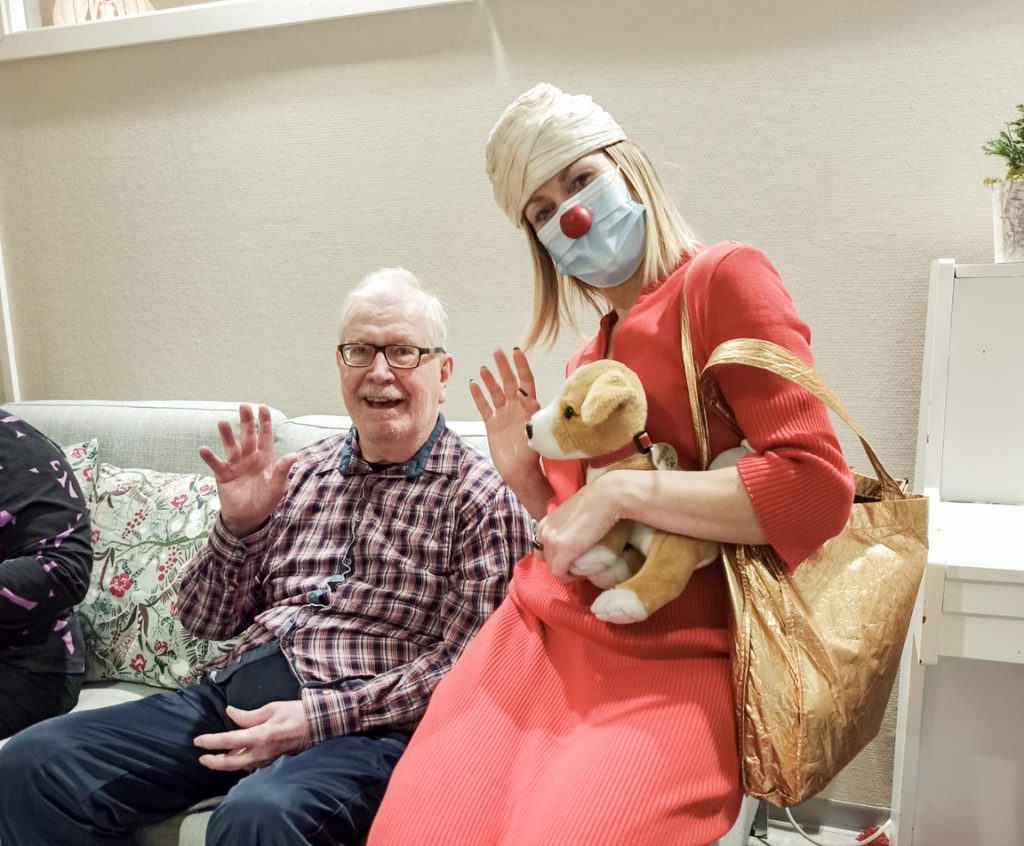
Elina Selamo and Janna Haavisto are healthcare clowns working with the Finnish Hospital Clowns Association, Sairaalaklovnit ry, in the regions of Kuopio and Turku.
They each have 11 and 18 years of clowning experience, respectively.
Working separately in their respective regions, Elina and Janna developed their own approach, tools, and scenarios for working with people with dementia in the course of ClowNexus, with the support of Sairaalaklovnit’s Artistic Responsible, Kaisa Koulu.
They worked both in pairs with other clowns and individually, each in different long-term care homes specialised in working with people with dementia.
In Turku, the homes to visit were identified with the help of the Alzheimer Society of Finland, which sent out information about the project to long-term care homes, inviting them to participate in ClowNexus by hosting the clown visits and the co-creative approach.
Three privately-owned homes replied to the invitation, and the clowns visited all three of them, totaling 26 visits, mostly as a duo, and sometimes solo.
The homes varied in size, housing from 36 to 100 residents.
In Kuopio, the clown artists contacted public long-term care homes with an invitation to host clown visits, and one was interested and selected for cooperation.
The home is a service housing facility where residents live in their own rental apartments and receive visits from home nursing carers.
The participating clown artists, most often working in a duo but sometimes solo, visited this home eight times during the spring and summer of 2022.
They interacted with a mix of the same and different residents, seeing people from once to five times.
Both artists frequently engaged with the staff in the homes to reflect on their work, particularly as working with seniors was a relatively new area for Sairaalaklovnit before the ClowNexus project. Giving names to the tools and approaches they were developing was a useful step in gaining confidence in the project and with this target group. An initial challenge, given the novelty of working with long-term care homes for Sairaalaklovnit, was identifying homes that were not only interested but motivated to engage in the co-creative work envisioned in ClowNexus.
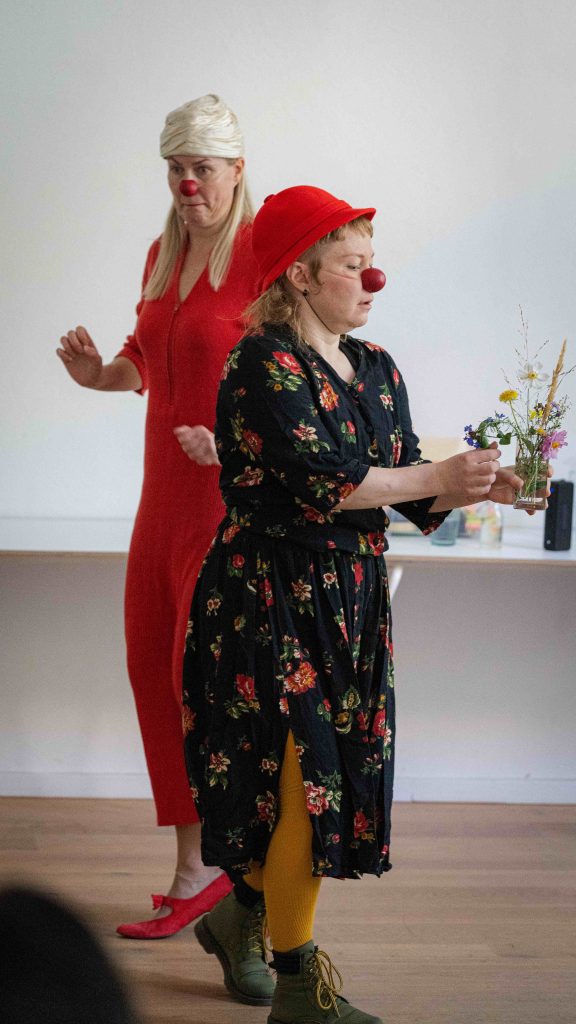
© Red Noses International – Miloš Vučićević
The artists used direct observation checklists and post-visit forms with staff and their own self-reflection to learn about the changes their work contributed to.
Deeper co-creation was possible in one of the homes, which is also the residence of the mother of one of the participating clowns – the staff would send pictures, share information with the clowns, and most highlights in this particular home happened thanks to the information sharing.
For people with dementia, the artists were able to observe various ways their encounters with visited seniors impacted them.
In the examples of the mirroring exercises described in this Artistic Scenario, the artists observed that the seniors they were engaging with became more relaxed in the shoulders and face, with eyes more open and clearer verbal communication than they typically exhibited.
In both instances, the mirroring technique through physical – speechless – play developed into a verbal exchange, including an open expression of gratitude by one senior.
Institutional carers – Through participation, even if passive, in the clowns’ encounters with the residents, the staff got to share in the energy changes in the room.
Family caregivers – The Finnish clowns had the opportunity to engage more with staff in the co-creation process, as family members were less available for encounters.
At the same time, in both Turku and Kuopio, clown visits unintentionally reached family members.
In Turku, one of the clowns visited a home that is also the residence of her mom, making her both the artist performing the intervention and its beneficiary, as the daughter of one of the residents being visited.
Visiting her mom in this role was the highlight of the project for the participating clown.
In Kuopio, the clowns visited an old man living with his wife, whom they always met together. In the words of the visiting clown;
“I think the clown visits were ‘something different and refreshing’ in her daily life. The wife also got a possibility to tell about their life, and I remember she enjoyed when clowns were singing or reading poems. She was also singing along with familiar songs.”
Clown artists – The participating artists had a need to experiment with and learn about artistic tools to employ when working with senior people in general and people with dementia specifically.
They tried out a variety of them – different variations on mirroring, entering with music, working with frames such as mirroring only hands or moving shoes, traditional hand clapping games typically played with children, active listening of verbal and non-verbal language, and mirroring that.
From the observations the artists shared on these explorations, a deep reflection is evident on aspects that worked better or less well.
The artists also embraced the ethos of risk-taking as part of the journey of discovery of the clown and its capabilities.
Healthcare clowning organisation – Sairaalaklovnit is an association of regional healthcare clowning chapters in Finland and was relatively new to working with older people.
Before collaborating as part of ClowNexus, they did not have experience working with long-term care homes, meaning they had no network or know-how within the association on establishing relationships with homes and developing approaches to work with older people.
As such, there was a lot of outreach work, learning, and exploration in this process, supported by the international learning and sharing that was at the heart of ClowNexus.
The Association really embraced this work, and as of autumn 2022, following an informational workshop for the Sairaalaklovnit clowns by the ClowNexus duo, the whole association started working with older people, with and without dementia.
The regular and nationwide clown work with older people was made possible by a major grant they received from the Funding Centre for Social Welfare and Health Organizations (STEA), a Finnish state-aid authority operating in connection with the Ministry of Social Affairs and Health.
In the grant application for this project, Sairaalaklovnit highlighted the learning from ClowNexus and the pilot visits.
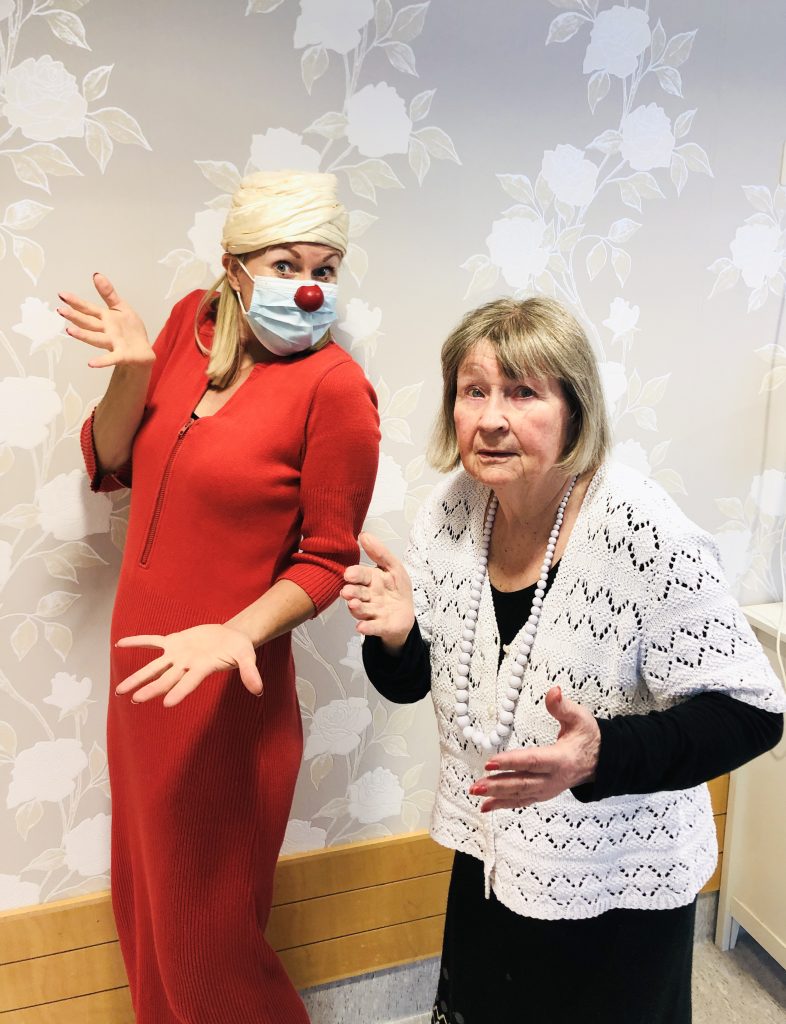
© Sairaalaklovnit – Amanda Aittamäki
Scenarios in Focus: Mirroring and mirroring hands.
Why interesting: Mirroring is a common approach used by healthcare clowns and received some attention in the workshops facilitated during the International Artistic Laboratories in ClowNexus.
The Finnish artists’ use of mirroring, including a specific focus on mirroring hands, in their respective regions and in different contexts, showcases the strong possibilities this simple approach offers for making a connection.
Intention: To connect; to play; connect to others through play; to activate the residents and invite them to move, including in small ways; to invite people to come out of their bubble.
Who participates: The scenarios involved residents – people with dementia, the clowns, and other residents and staff as observers. Active participation ranged from just one person to several, in the provided examples.
Duration: The mirroring exercises lasted around 15 minutes and can be extended to longer periods of play.
Setup of the space: Both artists worked in long-term care homes specialising in care for people with dementia.
For the general mirroring exercise, the setup needs to allow for a clear line of vision between the clown and the resident. For the hand mirroring exercise, a resident seated at a table works well. Both artists used this approach in the common area, accommodating the residents where they are.
Artistic skills needed: Mirroring; movement; sensitivity to sense the people; patience; ability to keep one’s artistic mind interested and playful; repetition.
Props: For the hand mirroring exercise, a table is helpful but not necessary.
Description: Below follows a description zooming into a specific experience of using mirroring hands by Janna and Elina.
The clown was standing and interacting with other residents sitting at the dinner table.
A resident came into the room and said hello. The clown turned towards him and made an exaggerated hello with her body.
The resident mirrored her movement. From this, the clown took the impulse of the mirroring game and started suggesting simple movements for the resident to copy.
The resident picked up the game instantly. Slowly, the game continued so that no one was leading the game, so to say.
The clown also took a little risk by suggesting more energetic movements which led to the resident suggesting boxing. In the end, they had a few minutes of air boxing together.
The clown didn’t want to continue the fast movements for too long as she wasn’t sure about the resident’s balance and fitness.
The clown stopped the game by announcing the resident as its winner by lifting his hand up, as in the boxing games, and led him to sit down.
Then the caretaker offered him a glass of juice to refresh from the movement. After drinking, he started to talk more about his boxing experience and other sport memories to the other clown who was sitting at the table.
It was a solo workday for Elina, and she had a group session in the common living room, including music and singing.
The artist was about to leave, and one lady waved her hands as a goodbye. For some reason, the clown started to mirror her waving, and they developed a waving dance together.
At first, the pair had quite a long distance between them. Gradually, the waving changed to both hands, and they were playing with the size and quality of the waving. The lady was sitting in one spot the whole time, and the artist was gradually moving closer to her.
In the end, the two had physical contact with their hands. When done with the dance, the lady looked the artist in the eyes and said, “thank you, you accepted me.” Then they said goodbye.
Repetition, eye contact, small changes, and simple movements are key – a common learning across the variety of artistic tools tried out by the healthcare clowns in ClowNexus for both target groups was clarity of communication – verbal or not – through a clear intention, repetition, and not overcrowding with additional stimuli.
Always on your time – likewise a common learning for various artists in ClowNexus is the importance of giving time for people to react, on their terms.
Giving time for the participants and going into their world instead of expecting them to adjust to the clown’s world and pace was among the learnings of what worked for the participating Finnish artists.
Likewise, and on the flip side of this, was a learning to consciously work to slow down the clown’s ‘pilot’ who is constantly offering impulses of things to suggest in a given game – this, when a participant can’t keep up, can trigger them to shut down and disengage from the game.
Human interaction is much more about being present and hearing, and not about understanding the words – this learning is a direct quote from a reflection of one of the participating Finnish artists, and illustrates that the clown with all its empathy and capabilities is well-placed to hear and be heard by people of different abilities, even if no language, or a different language is involved.
This learning came from a scenario where the clown used mirroring to help her come down after being triggered by a waving red scarf in another clown’s performance to relive a difficult experience.
The clown’s subtle mirroring, whereby they accepted the woman’s upset mood, listened to her speaking in her own language, and really understood the emotions there while kneeling at her side, led to her calming down and even laughing at the scene that resulted with the clown.
Risks are risky but can be impactful – in the same example with the red scarf, though effectively a ‘dangerous’ symbol that may be avoided in the healthcare clown toolkit, its use in the scenario evoked a reaction, even if with a negative mood, an episode of verbal communication.
In other instances, the clowns were not able to evoke a reaction from this resident. The important caveat is that the clowns were there to turn around the reaction their own scenario produced to a pleasant one for the participant.
© Pallapupas Spain
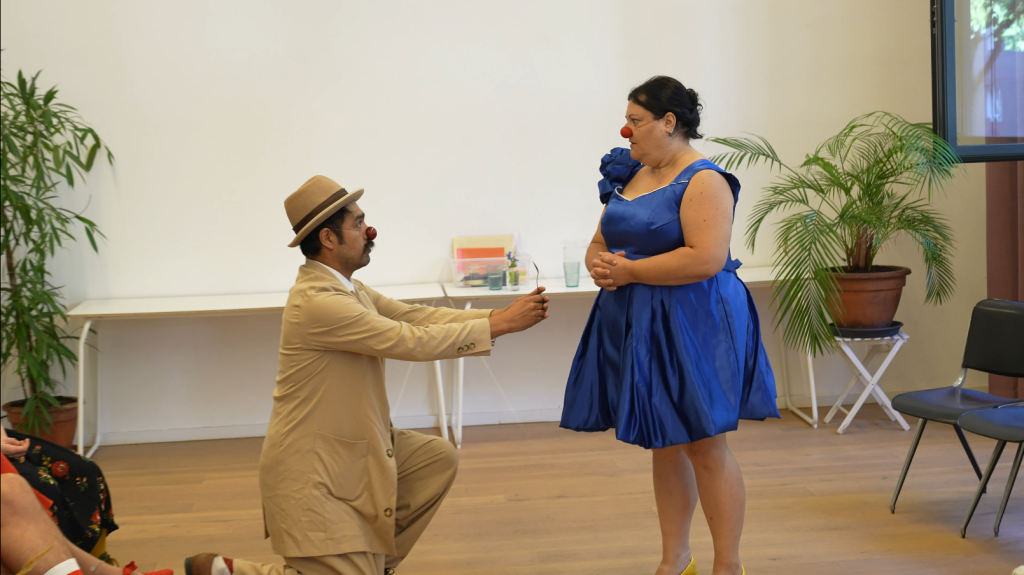
Ricardo and Núria are experienced healthcare clowns working with Pallapupas, a healthcare clowning organisation in Catalunya.
As part of ClowNexus, they worked with Fundació Pere Relats, a non-profit care home that caters to people with dementia. They had been visiting the home for around a decade before ClowNexus started.
During the project, it was one of several homes where they had the opportunity to engage in regular and in-depth work with individuals with dementia, as well as with their care staff and families.
The home was selected because the administration enthusiastically received the clown visits and the EU project, and gained confidence in healthcare clowning approaches.
The administration’s investment into the project was further confirmed by the home agreeing to host a group of visiting clowns in an International Artistic Laboratory that took place in Barcelona, and later also observation visits by evaluators.
At Fundació Pere Relats, a multidisciplinary team filled the clowns in on the latest developments of the residents prior to each visit. The duo also sometimes got to see family members who visited the centre frequently.
People with dementia
For the residents, there is a need for stimulation in their daily routine. It’s important for them to be engaged, included in games and connected with other residents, staff and visitors.
Activities such as the parachute game described below, also proved very favorable for engaging the senses – where beyond visual stimulation people can touch and feel movement from their own and others’ impulses.
Impacts observed by the artists were increased feelings of joy and fun among the residents; changes in mood and activity levels from passive to being more cheerful and lively; and changes from low to high energy levels.
Institutional carers
For the staff in the home, there was a need to connect with the residents, find ways to engage and experience new ways of interacting with them. The clowns observed the staff’s enjoyment and engagement in the activities, including through physical activity e.g. jumping.
Clown duo
The clown duo had a need to find their feet in the new project, and they mentioned the International Artistic Laboratories as something that supported their journey considerably.
The clowns developed new ways of working and a deeper appreciation for the needs of older persons and persons with dementia specifically, as well as the people surrounding them.
Their ClowNexus experience was accompanied by feelings of gratefulness, increased self-reflection and an expansion of their comfort zone.
Furthermore, the connections built with the residents and staff were a reward for the duo.
Healthcare clowning organisation
Pallapupas has been working for many years with geriartic programs, specifically with people with dementia, and has had a long-standing and deep cooperation with Fundació Pere Relats.
ClowNexus provided the opportunity to investigate and explore, through co-creation with staff and family, creative approaches to reach people with dementia.
A golden opportunity emerged for the artists to grow, improve and critically approach their methods.
Thanks to the collaboration of different paths, work systems and experiences from other countries during the project, Pallapupas, the participating artists and creative managers could dedicate the necessary time and focus to this work.
The organisation aimed to advance their intervention with older people in residences and social-health centers to be able to integrate healthcare clowning into the health system of older persons.
Pallapupas is currently advocating for a model of care that is better for the users, but also preventive, effective, lasting and efficient within the social care system.
Therefore, Clownexus served as a source of knowledge that will allow Pallapupas and participating artists to further their cause.
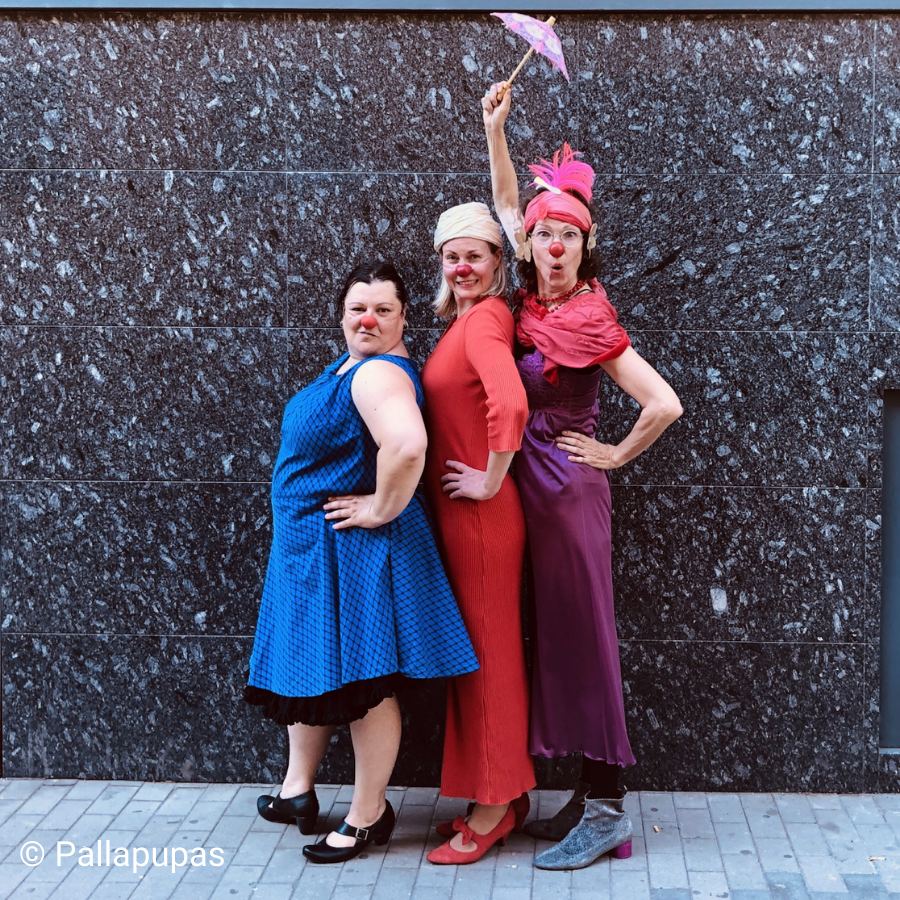
The duo used a variety of artistic tools including movement and slapstick, conscious use of space, creating with an object, and playing with voice and sound.
Scenario in Focus: Flying with a parachute
Why interesting: a parachute is an object with a clear purpose that is recognisable and easy to relate to.
Its use in the living environment of the residents, allowed the clowns to transform its meaning during the artistic encounter.
The parachute, an object that represents movement and flying, sparks the imaginary and fantasy realms and helps residents to transform and surpass the possibilities of the home’s living room.
Intention: To disrupt the space, create a relationship
Who participates: Residents, staff and relatives who are present, and the healthcare clowns
Duration: 2-2,5 hours
Setup of the space: The clowns and staff, and others who are present at the time of the visit, fly the parachute in the living room – a big common area used by the residents of the home.
The residents are around it, partaking in the activity and holding the parachute, touching and moving the additional soft objects that sit on the waving parachute.
Props: The parachute, various soft objects, table, fans under the table (see phase 2).
Description: The parachute game can take up to two hours or longer, and it involves a process of building up, as described below.
Phase 1: Everyone is seated around the parachute which is supported by people around it. Initially, the attention is on each resident individually, allowing each one to engage, touch the parachute, and then move on to the next person.
The pilot of the parachute is also in the game, directing attention to the other flyers. The soft movements of this object with each interaction awakens people’s attention and interest.
Clowns invite the audience to play by throwing soft objects on it or just simply having fun by observing how others react to and interact with the game.
The clowns are sensitive and attentive to reactions around the parachute and build up the play accordingly.
Phase 2: After letting the parachute hang in the air while being held by those around it, the clowns put a table under it and one clown lays on it.
This aspect in the game resulted from a recurring focus in International Artistic Laboratories for clowns to explore taking risks.
The risk in this case was a physical one, whereby the clown lying on the parachute, which is supported by the table, is able to fully rely on the structure and take flight.
The allusion to flight is also reinforced by using fans under the table to make the parachute flutter. The clown’s movement, as well as movements of the soft objects around the parachute, simulates the sense of flying.
The audience gives impulses by moving the object, and the clown reacts on these.
Stimulation of the senses can go further
The clowns observed the benefits of engaging the residents’ senses, which they felt could be taken even further by including more sensorial objects like feathers and leaves, and even include sounds like wind or birds flying to go with the theme. The theme of flying could be further reinforced by the clowns wearing aviation-like costumes.
Could explore the game with people with advanced dementia
The parachute was flown in the common area, meaning only those residents who could make it there were included. At the same time, the clowns believe it could also work with people with advanced dementia that cannot attend activities outside their wards.
Togetherness helps overcome limits
When people with dementia get a chance to partake in a joint activity with relatives and staff, instead of as passive observers, they become equal participants. The clowns felt this was a transformative element, whereby the common game and sense of togetherness helped overcome limits.
© Mindaugas Drigotas, Berta Tilmantaitė – NARA
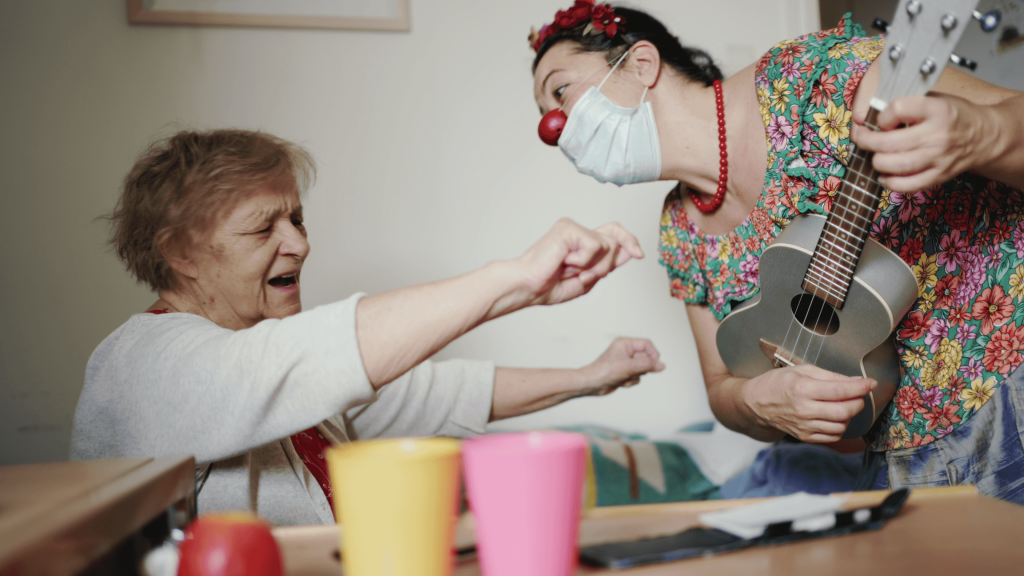
Tünde Gelencsér and Andrea Kiss have 21 and 20 years of clowning experience, respectively.
Tünde is the Artistic Director of PIROS ORR Bohócdoktorok Alapítvány in Hungary and was also the artistic lead for the clown duos working with persons with dementia in ClowNexus.
In addition to clowning, Andrea is also a mental health professional and has experience working as a mental hygienist in the same long-term care institution she was visiting as an artist in this project.
Andrea and Tünde worked together to co-create the artistic tools and approaches for visits with persons with dementia in Hungary and in the International Artistic Laboratories.
However, they went on visits to the homes with other duo partners.
While Tünde works in Budapest, Andrea is part of a team working in the southern city of Pécs.
This approach of learning together and then working with wider teams was intended to share their experience in the project with more clowns in PIROS ORR.
The clowns, therefore, developed their tools together and started building up a team to cooperate with them in visits, sharing their learnings through workshops for the participating clowns.
Since hosting the first International Learning Laboratory in October 2021, the Hungarian clown artists engaged in regular exchanges with the team of clowns working on the project to exchange ideas, feedback, discuss obstacles, and emotions experienced along the way, developing their approach accordingly.
The artists pointed out that in this process, they ended up fine-tuning their approach before each and every visit.
In Budapest, ClowNexus visits took place in three homes.
In Pécs, the clown artists visited one home.
In Budapest, two of the homes were already in cooperation with Piros Orr, visited by clowns on a regular basis since 2014.
One institution was a new partner, chosen because the home has a mid-stage dementia ward and also a late-stage dementia ward. The choice of the institution in Pécs was based on an existing cooperation with Piros Orr and the support of the experts.
As Andrea is working in this institution as a mental caregiver, it was a great opportunity to work on a special program for people with dementia, inviting the staff into co-creation and monitoring the impact in the same place.
The latter was selected as a home PIROS ORR were already cooperating with the most, through a program called Hotel Sunshine – a clown-made ‘telenovela’ for persons in long-term care.
The approach there was to transform the existing program specifically for persons with dementia.
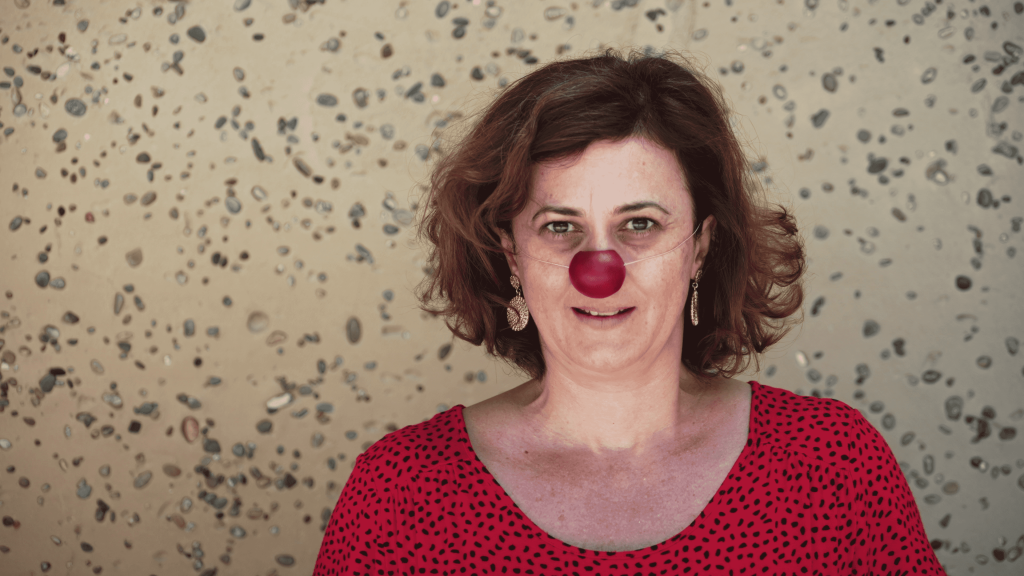
© Mindaugas Drigotas, Berta Tilmantaitė – NARA
Persons with dementia – The clown artists found that they really managed to make a connection with the persons visited, contributing to changes in the mood of individuals but also an overall change in the environment in the department they’d go to.
Clown visits also acted as a connector between the people in the wards, awakening their interest in and communication.
Institutional carers – The clown artists, through the deeper-level co-creation with the institution they visited, were able to build trust with the institutional carers.
The regularity and depth of exchanges on what the clowns are attempting to do and how it works out in the individual visits developed into the carers counting on the clowns to connect with their clients, and vice versa, the clown artists counting on the carers for information and mentoring on also what they see as working and when.
In the words of one of the clown artists, “it is already not like visiting a place; it is much more like working together.”
Family carers – In the context of visits to one of the three institutions cooperating with Piros Orr in Budapest, family members, mostly children of the seniors visited, were available for co-creation.
The family members joined a clown visit and attended a discussion with the clown artists afterward to share their first impressions, feelings, needs, and also how they saw their relatives during and after the clown intervention.
Later in the program, the clown artists invited the family members again to experience a clown visit with their loved ones again.
Clown artists – Before ClowNexus started, Andrea and Tünde had been visiting long-term care homes and already felt the need to do something special for people with dementia.
The co-creation and exploration built into the ClowNexus approach resulted in a stronger cooperation with different stakeholders.
The clown artists say they feel much more familiar with the institutions they visited. In the end, this translates, for the clown artists, into more freedom to try out new ideas.
The clowns became more sensitive with their own senses, in addition to working with the senses of the people they visited, and feel the tuning made possible by the experience in the project made them more attuned to themselves as people and artists.
Healthcare clowning organisation – PIROS ORR had not only participating clown duos but also the Artistic Director with a leadership position in ClowNexus, leading to a lot of learning and sharing.
In the spirit of sharing their experience in the organisation, Tünde and Andrea facilitated workshops and presented their work with persons with dementia in Clownexus in several sessions as part of conferences and national clown camps.
With the start of visits to people with dementia under ClowNexus, the Hungarian clown artists changed their approach from visiting individuals in their rooms during geriatric visits to seeing them in groups in the common areas.
They played around with metaphors of ‘containers’ – backpacks, suitcases, and bags as containers of memories.
In Budapest, the team played with calling memories with a topic and an object that has a strong sensory impact, to also build a common activity with, something the seniors recall doing in their daily lives.
As part of the activity, the clown artists used music, children’s songs, and rhymes.
The idea behind the tools they opted for was to create an intimate connection with care home residents, who are often seated together in common areas, without having too many props.
The Hungarian clowns also experimented with ‘natural ingredients’ – things relating to nature and the seasons, to plants and fruit, references to which are in abundance in Hungarian folk songs.
Two scenarios from the clowns’ visits are described below.
Scenarios in Focus: (1) Washing Clothes and Drying & (2) It’s Raining
Why interesting: Both scenarios involve creating with an object and a mix of movements and sounds to connect participants with a lived experience from the past.
Intention: Both scenarios have connecting the group and sensory stimulation as a common intention. Also, while the “It’s Raining” routine is meant to connect people with nature and stimulate the senses; the “Washing Clothes and Drying” exercise particularly aims to tap into people’s memories of this much-experienced commonplace activity from the past.
Who participates: residents, staff, relatives
Duration: 15-20 minutes for “It’s Raining”; 30 minutes for “Washing Clothes and Drying”
Setup of the space: Both scenarios take place in the common room in long-term care homes.
“Washing Clothes and Drying” always requires a group of participants, whereas the “It’s Raining” exercise can work in one-to-one settings or smaller groups that can fit under the umbrella.
Artistic skills needed: Artists need to be skilled in creating with an object, musicality, and storytelling.
Props: “Washing Clothes and Drying” requires a washbasin and scarves; “It’s Raining” calls for a colorful umbrella.
Description:
Washing Clothes and Drying is a proposition to play a game of playing with a familiar activity, washing clothes. It starts with clowns entering the common area with scarves in a big washbasin.
The idea is that the clowns play with the “dirty clothes” – the scarves, using them for sensory impulses – washing movements with their hands, moving the scarves for drying with the flying scarves at the end emanating a fresh smell.
The clowns then invite the residents to partake in the activity – they dip the “dirty clothes” into the washbasin and start a rhythm and singing to accompany the collaborative washing.
The washing movements quickly activate people’s physical memories of this activity and connect them to the topic of the game, with music further supporting the group connection to the common activity.
The clown game then extends to the drying of the clothes, with the clowns erecting a long drying rope with clothespins for the residents and staff to use to hang the laundry.
The hanging clothes smell fresh and clean, and the group sings again to solidify their connection.
It’s Raining is also a tool focused on sensory stimulation and, in this case, a connection to nature.
The clowns enter the common area with a big, colorful umbrella. The first connection is going through the object, awakening interest and opening the topic of the rain for the participants.
The duo starts to build the play by creating sounds of nature, the wind, and the rain by blowing, tapping the objects they have, and using soft rhythm instruments.
The clowns open the big umbrella and invite the audience to hide under it. The play is better suited for individual play or for a very small group.
Under the umbrella, the participants listen to the sounds of the rain, which can come from tapping fingers on the umbrella.
The clowns then develop the play with the emotion and impulses coming from the audience.
Rain is a strong connector to emotional memories, and thus the play overall has to be very intimate and sensitive, aware, and reactive to the people taking part. The aim is to keep the intimacy with soft variations in the play.
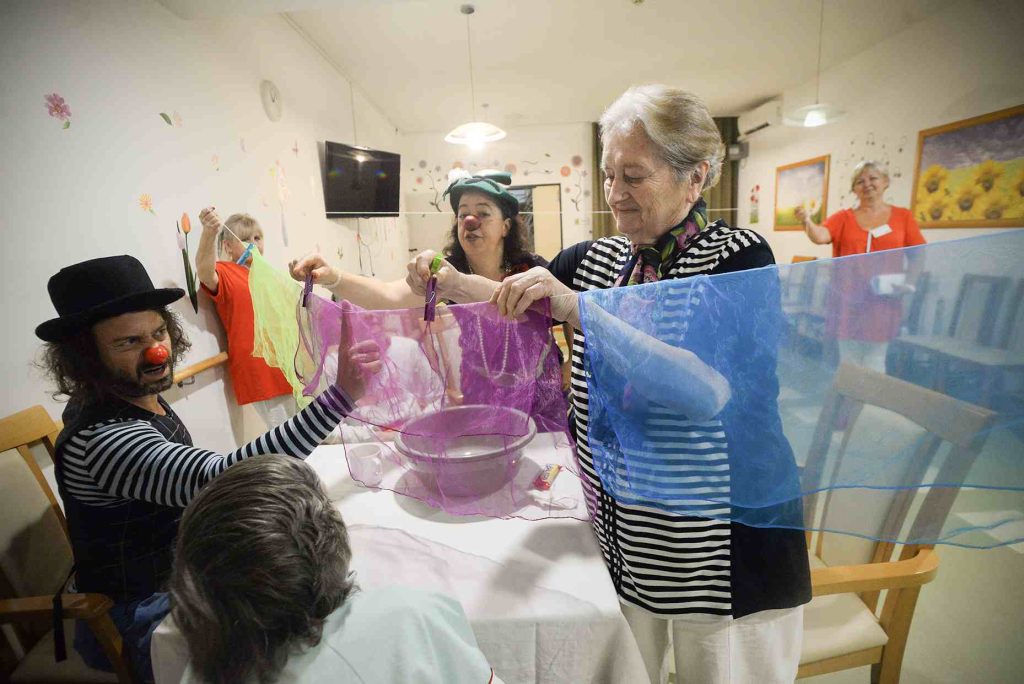
©PIROS ORR – Vera Éder
The more time, the better with people with advanced dementia – during COVID and the changing dynamics of visits, the Hungarian clowns accidentally spent twice more time than they normally would in a visit with people with advanced dementia.
The duo finished going around the floor (clowns visit all the floors/wards in the homes) and instead of heading up to the other floor came back for one more round.
This time, instead of the first time around, the people were already high energy as the clowns had warmed them up, and it was possible to go even higher. The learning was that it worked very well to give more time to these visits.
Clowns connect and play with people with dementia through association – during the visits, clowns focused more on giving the time to build a connection.
A realisation that came from the moment when the clowns were really connected in the midst of their intervention was that the clown’s presence is free of constraints of time and connects smoothly to the associative logic of people with dementia.
The clown logic and the free association of the resident with dementia is connected in strong playfulness and creates a lot of joy. This associative logic is useful for the clown to be driven through improvisation.
How to deal with aggressive behavior – in the visits with persons with dementia, the clowns were minimalistic and simple in the approaches they employed.
The risk involved in the less artistic approaches is that the simplicity can be misunderstood, also emotionally.
An example was a situation with a woman one of the duo clowns accidentally triggered by accidentally hitting a wall during their interaction. This made the woman react aggressively, and the clowns tried to find something she didn’t react so strongly to.
The duo let her follow them while they made their little journeys around connecting to other residents. In the end, this amounted to a long journey for the woman, but eventually, she was standing calmly next to the clowns.
What worked to appease her anger was that the clowns acknowledged her authority while keeping a distance, allowing her the chance to show what she felt.
© Mindaugas Drigotas, Berta Tilmantaitė – NARA
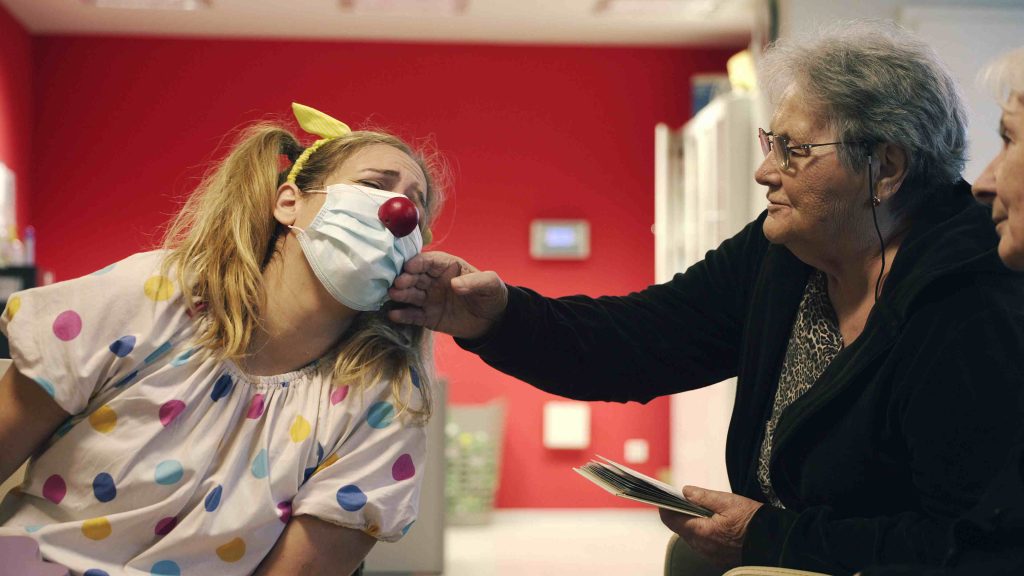
Irena Kolar Vudrag and Sendi Bakotić are healthcare clowns working with CRVENI NOSOVI Klaunovidoktori, collaborating with the Zagreb and Rijeka teams.
Sendi has 3 years of experience in clowning, and Irena has 11 years.
Irena has been working with older people since 2011 and, since the beginning of ClowNexus, she has felt a mission to bring good feelings, laughter, and love to this group.
She found her space and a desire for professional growth in working with older people.
For Sendi, her first visit to a person with dementia as a clown started with the beginning of ClowNexus. However, as Sendi recounts in this blog post, she has experience with dementia as a granddaughter of someone afflicted by it.
The clown artists were selected on behalf of the Croatian Red Noses organisation to participate in ClowNexus and focus on approaches to working with the elderly with dementia.
The pair participated together in International Artistic Laboratories as part of the project, co-created their approach to visits within the project’s framework, and went on visits together in Zagreb, despite Sendi being based in Rijeka and traveling for the visits two days per month.
They visited residents in two long-term care homes. On the rare occasions that one of them could not make a planned visit, the other would go on solo visits.
The clown artists each worked in long-term care homes specializing in working with people with dementia in their respective cities.
They selected two residences that were already partners of CRVENI NOSOVI and that had separate dementia wards.
Croatian clowns had been regularly visiting one of the homes for over 10 years.
The other home was visited by a special CRVENI NOSOVI project – clown band Ni Neki Bend – and the staff had already expressed interest in receiving regular clown visits.
This home worked well for the ClowNexus visits, particularly because they had dementia wards on two floors, providing many older people to visit.
CRVENI NOSOVI Klaunovidoktori had been visiting elderly homes since their founding in 2010.
Inside some homes, there are dementia wards, and in many of the homes, older people with dementia are present in different residential sections alongside other elderly who don’t have dementia.
For example, in inpatient care, older people with and without dementia share spaces.
The Croatian clowns met people with dementia during their regular visits but didn’t always have appropriate tools or enough time to connect with them because they were often placed in rooms with other residents.
Since Sendi and Irena’s experience in ClowNexus, they provided workshops for colleagues and will now share their learnings with CRVENI NOSOVI artists in their respective cities.
The Croatian clown artists gathered information about the people they visited from institutional and family carers.
This information included insights about the professional and personal lives of the residents, which later served as inspiration for developing and selecting tools and topics to address in their visits.
After the visits, the artists documented their experiences in post-visit reports, highlighting special moments that left an impact on their memories.
In the spirit of co-creation, a principle embraced by the ClowNexus project, the clown artists engaged more deeply with the long-term care homes they worked with. They held panel discussions halfway through the project and at the end, outside of the care homes, inviting staff members and families to share their observations and feelings about the impacts they had experienced.
People with dementia: A heartfelt recount of a daughter of one of the people visited by the clown artists, available in a video portrait here, talks about the changes she observed for the people visited by the clown artists.
From her observations, she finds the clowns act as mobilising agents for the residents who would typically be sitting alone, watching TV, or engaging in other activities.
She notes, “But when the clowns are there, it’s different – they’re laughing, they’re interactive, they’re singing, dancing, they’re clapping with their hands, it’s very nice.”
Institutional carers: The Croatian clown artists’ experience with the institutional carers in the two homes visited was genuinely co-creative.
The institutional carers extended their trust to the clown artists, sharing detailed information about the residents to be visited as part of the initial research and preparation process, and continued this collaboration throughout.
The mutual benefit was realised through the clown artists sharing their expertise in connecting with people with dementia by demonstrating it during their visits.
Family carers: The above-mentioned video portrait illustrates beautifully how a family member experienced the clowns visiting her mother.
She notes, “When I saw my mother, she was dancing and she was laughing, she was hands in the air, I was very happy.”
Overall, the Croatian clowns had substantial contact with family members, initially meeting with them to learn about the people to be visited and to understand the family members’ wishes for their loved ones.
Family members were also invited to, and some attended, the panel discussions mentioned earlier to share their experiences of working with the clown artists.
Clown artists: Irena was able to realise her mission to bring something special to her work with older people in general and to focus specifically on people with dementia.
She found her passion and expressed her wish to continue raising awareness of dementia.
She also aims to create a theater play or a book about dementia clown visits and continue to grow professionally in this field.
Sendi went from her initial visits as a clown to people with dementia to developing a deep appreciation for interacting with this group.
Healthcare clowning organisation: CRVENI NOSOVI was already well-established in working with older people.
Still, the focus on dementia provided by ClowNexus was unprecedented.
The organisation wholeheartedly embraced the opportunity to learn and share these learnings through having clowns in different cities working separately.
This enabled them to expose more people to the expertise and learning generated from the project. The participating clowns also held a four-day workshop for all interested clowns in the organisation.
They also incorporated learnings from their participation in ClowNexus into both the groups working with dementia and ASD, culminating in a larger sector event, including an exhibition and panel, in October 2023.
The event was attended by medical staff, heads of institutions, policymakers, media, artists, and clowns who experienced the type of work with the senses undertaken by the clown artists in the project.
Below is a description of one of the several tools explored in practice during ClowNexus visits by the Croatian clown artists.
The artistic tools they employed centered around musicality, transformation of the space and time, and recollection of memories.
Scenario in Focus: Oldies are Goldies Party
Why interesting: This scenario creates an immersive experience for the participating residents using mediums that everyone can relate to, namely music and a party atmosphere.
Intention: The clowns invite the residents to share in the party mood to change the atmosphere, travel back in time, recall memories, and make the residents feel beautiful.
Who participates: Residents, staff, and clowns.
Duration: The party is a process that includes a warm-up, dressing up together, and living the experience itself. The duration can be around 1 hour and 30 minutes.
Space setup: The party takes place in a common room open to all interested residents.
Artistic skills needed: Musicality, dancing, storytelling, and creating with objects.
Props: Old/loved objects that resemble the past, such as a knitted tablecloth, a portable suitcase-vinyl record player with a collection of old records, and a Bluetooth speaker for playing songs on the fly.
To get the residents into the party mood, the clowns bring paraphernalia like jewelry, scarves, and other items for dressing up.
Description: The clowns bring old objects to decorate and create a retro party atmosphere. The retro objects trigger memories and help establish a party atmosphere as the residents knew it when they were young.
The invitation is for everyone to join and have fun together. The clowns and residents dress up as they like, get in the mood by choosing beloved songs together, and co-create a party.
Listening to music, dancing, and engaging with the energy bring joy. As a party is a fast-paced environment, it is essential to adapt this reality to the participants. The clowns found it important to take the time, go step by step, and not overwhelm the residents with too many impulses.
Creating the atmosphere together and allowing participants to choose their own rhythm and pace is crucial.
The activity can evoke strong memories, so it’s essential to provide enough space for the residents to experience their emotions.
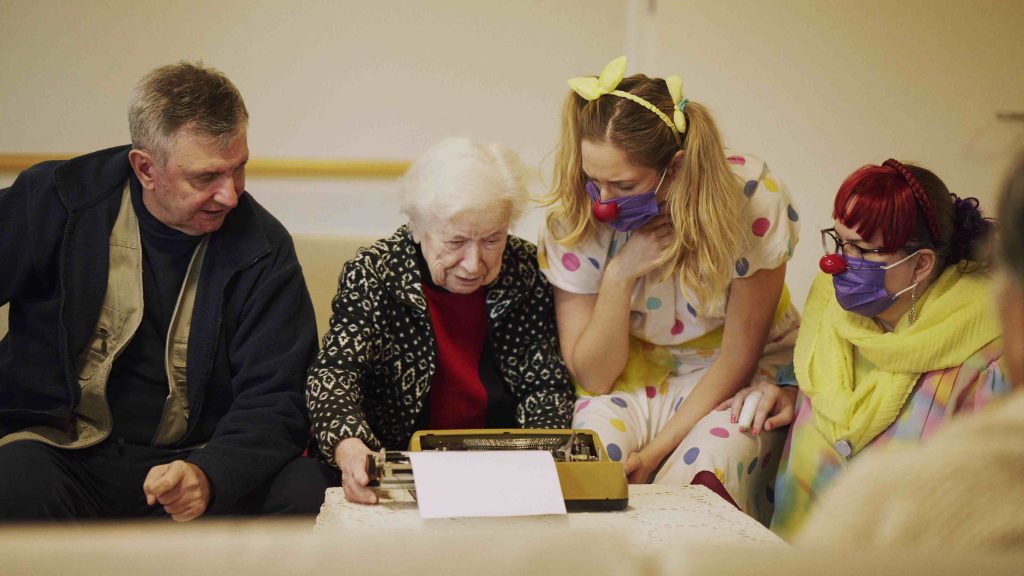
© Mindaugas Drigotas, Berta Tilmantaite – NARA
Familiarity Matters: Enjoying parties is often influenced by being in the company of familiar people.
The clown artists learned that this scenario is better received when the clowns, possibly the same set of clowns, establish a deeper connection with the residents through previous visits. The residents were more receptive and festive when they had a stronger bond with the clowns.
On occasions where there was a gap in visits, like during the summer vacation period, the scenario had less success as the residents had grown more distant. It took some time to reestablish the connection, which happened through simpler methods.
Props’ Practicality: The artists discovered that there can be a disconnect between the idea and practice, not only in experimenting with artistic tools but also with the props used.
In the Oldies are Goodies party scenario, the vinyl record player and records were more suitable for decoration than for playing music. It was more practical to use a Bluetooth speaker or a personal mobile phone to play songs.
Additionally, props are most useful when someone closely engages with them, actively using them. Props can be powerful when used in this way and create memorable connections.
Creativity and Humor Persist: The artists learned that even when people face memory loss and cognitive challenges, they can still connect through creativity and humor.
These core aspects of the human experience endure, and they provide a meaningful point of connection.
A specific example of an emotional connection through creativity and humor is documented in Sendi Bakotić’s blog post.
The Importance of Regularity: Regular visits are essential, not just for the well-being of the seniors but also for maintaining the strong connection between the residents and clowns.
Gaps in visits can lead to fading memories of the clowns, and it may take time and effort to reestablish that connection.
Working in duos and sharing experiences with other teams and professionals helped during these transitional periods. International Artistic Laboratories also played a vital role in re-establishing connections.
These lessons from the ClowNexus project offer valuable insights into improving the quality of life for people with dementia and demonstrate the power of artistic tools in healthcare settings.
© Red Noses International – Miloš Vučićević
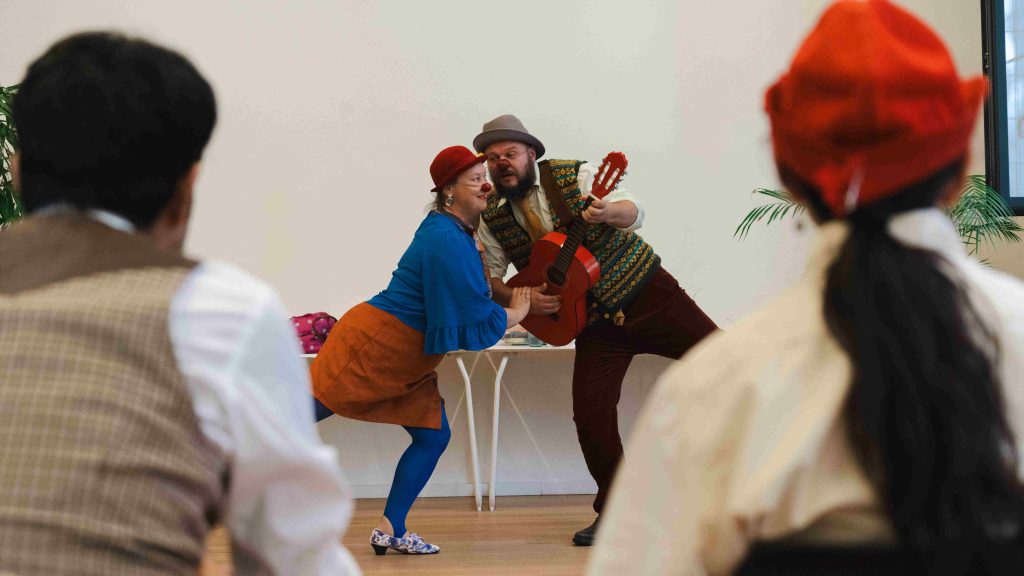
The Lithuanian healthcare clowning organisation, RAUDONOS NOSYS, part of the RED NOSES International network, had a well-established older people program and clowns trained in approaches to work with older people even before their involvement in ClowNexus.
Between 2021 and 2023, independent of ClowNexus but with support from the RED NOSES International’s Innovation Fund, they developed a novel program for visiting older people living in remote areas, known as “Clowns on Wheels.”
Simultaneously, ClowNexus introduced a dedicated focus on dementia, especially advanced dementia, for three selected clowns.
Justinas Narvydas, partnered with Severina Špakovska and Joana Čižauskaitė, embarked on visits as part of this project.
Justinas possesses 11 years of experience in clowning, while Joana has been a healthcare clown for 12 years, with the last 8 years dedicated to working with older people.
The Lithuanian clown artists and RAUDONOS NOSYS collaborated with two long-term care institutions during the project. One was a long-standing partner in Vilnius, which the clowns visited extensively in the early exploration phase of the project.
The other was Addere Care home in Trakai, a new partnership for the organisation.
The clowns dedicated most of their visits through ClowNexus to this new partner. The initial connection with Addere Care was facilitated by Joana, one of the participating clowns, who also works as an occupational therapist and had a pre-existing relationship with the institution.
The collaboration with Addere Care began with a conference in June 2022, named ‘About the Organisation and Dementia,’ where both parties co-created a set of anchoring principles focused on a holistic approach to dementia care, aligning with HM Queen Silvia of Sweden’s Silviahemmet Care Philosophy, which was implemented in Addere Care.
The clown artists conducted approximately three visits to Addere Care each month, with one visit being led by a clown duo, and the other two by solo clowns.
Additionally, they organised seasonal visits specifically for the care staff, with the most memorable being during Christmas, when clowns, staff, family members, and residents joined in a collaborative game to fulfill residents’ wishes.
This event fostered a strong sense of community and appreciation among all participants.
The Lithuanian clown artists assessed the needs of the residents in consultation with the staff, discussions between clown duos, and insights from the program manager.
In the early stages of the ClowNexus project, a baseline study was conducted using the “My Favorite Story” tool to gauge the requirements of older people living in the care homes.
People with dementia: The visits by both clown duos and individual clowns provided residents with a delightful communal humour shower, brightening their mood and offering various engaging activities.
For some older people who had previously displayed aggressive behavior, the clowns managed to break the ice and develop tools in collaboration with the staff to cope with anger and rejection more effectively.
Feedback from family members also supported the positive impact, with one family member noting that her mother felt happier and remembered the clowns after the visits.
Institutional carers: Institutional staff became well-acquainted with the clowns’ abilities and found them particularly valuable in situations where they encountered difficulties.
The clown artists’ presence inspired the staff, who acknowledged the clowns’ ability to handle complex moments and contexts.
Clowns often acted as mediators to help connect with older people who had been challenging to reach.
Family carers: Family members were encouraged to participate in the opening conference and attend clown visits.
Seasonal celebrations, such as the Christmas gift exchange, provided opportunities for family members to share in the joyful atmosphere created by the clowns and interact with their loved ones in the care home.
Clown artists: Both Justinas and Joana, who already had a profound interest in working with older people before ClowNexus, solidified their focus on clowning with older people with dementia through their participation in the project.
The experience transformed their thinking, making them more attuned to the changes experienced by the residents they visited.
They learned to pay attention to small details and were empowered to share their insights with their colleagues.
Healthcare clowning organisation: In parallel with ClowNexus, RAUDONOS NOSYS developed the “Clowns on Wheels” project, expanding their efforts to work with older people, including those with dementia.
Joana and Justinas became resources within the organisation to educate other clowns on their experiences working with older people with dementia.
They held a workshop in September 2023, sharing the knowledge they gained through ClowNexus, and the organisation conducted a closing event in October 2023, showcasing their experiences and inviting various stakeholders.
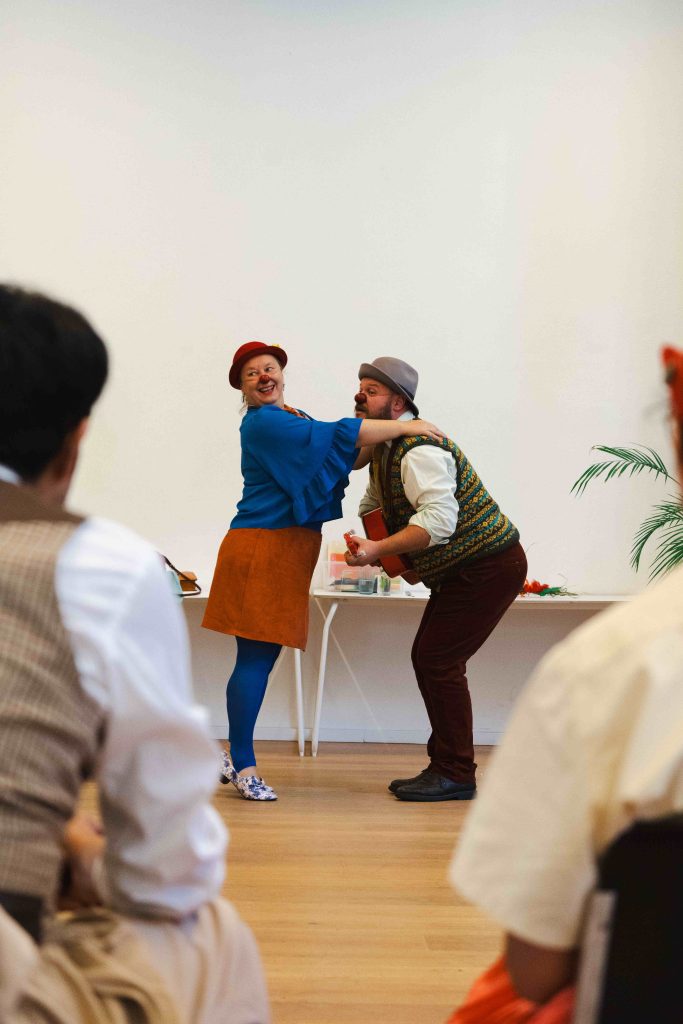
© Red Noses International – Miloš Vučićević
The Lithuanian clown artists experimented with various artistic techniques during their visits to older people with dementia.
The approaches varied, depending on whether they visited as a duo or as solo clowns.
One of the clowns incorporated music with instruments, while the other, also an occupational therapist, blended clowning with occupational activities such as drawing and handicrafts.
Rhythm, repetition, movement, object manipulation, and slapstick techniques played a significant role in their approach.
Here’s the story of one of the tools they used during their visits as a duo:
Scenario in Focus: Train to the Seaside
Why interesting: This scenario employs the concept of a familiar mode of transportation, evoking sensory memories such as the sounds of a train station, the wind from an open window, and the smell of the sea.
The journey framework provides a clear storyline while allowing improvisation and engaging multiple senses.
Intention: To transport participants into a sensation of traveling, evoke memories of past journeys, stimulate their imagination, and bring the joy of adventure.
Who participates: The clowns facilitate, and a group of older people take part, while staff can observe and join in the activity.
Duration: The activity typically lasts between 30 to 50 minutes, considering older peoples’ attention spans and needs.
Space setup: The journey takes place in the common area of the care home, or outdoors depending on the season. Participants are arranged in a circle or as they prefer, with flexibility to move during the activity.
Artistic skills needed: Musicality, rhythm, storytelling, and clowning.
Props: A ukulele for music, a suitcase to enhance the travel experience, and a large blue fabric for simulating the sea.
Description: The clowns enter the common area, playing a melody suited to a seaside trip, and simulate the sounds of a bustling train station as they move through the audience, creating an appearance of being in a hurry.
Their rush is amplified by slapstick elements and comedic mishaps that impede their progress.
Eventually, they make it onto the imaginary train, ensuring all participants are accounted for. They play out the train journey, complete with stops, restroom breaks, and train sounds.
Upon “arriving” at the seaside, they unroll the blue fabric, inviting participants to touch and feel the “sea” and engage their senses.
The day trip concludes with a return to the train station and a train ride back home. The clowns exit the common area in the same playful manner they entered.
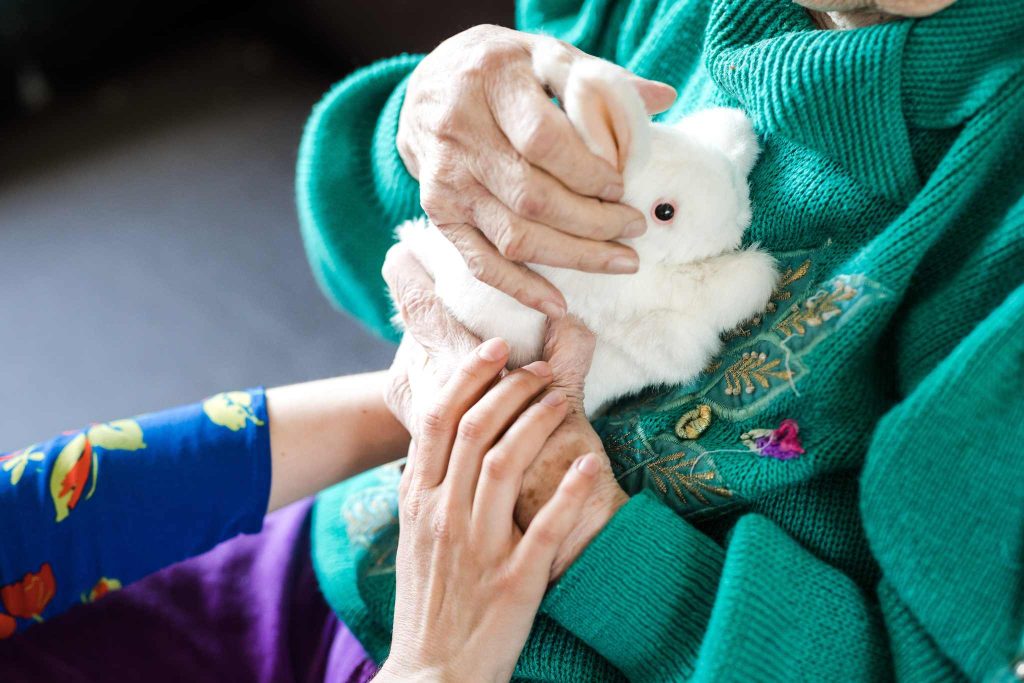
© Saulius Aliukonis
The significance of dressing up: The clown artists noticed that their apparel not only influenced their demeanor during visits but also played a vital role for the older people.
Residents paid attention to the clowns’ attire, and it became an artistic tool and an invitation to play.
For instance, Justinas’ choice of loose-fitting clothing often led to humorous interactions with residents.
The clowns adapted their outfits according to seasons and holidays, such as dressing as Santa and his helper during Christmas.
Humility and honesty are effective: The clown artists learned that staged approaches to capture residents’ attention, such as rearranging furniture, were less effective than allowing interactions to flow naturally.
Being in the moment and taking time to build relationships without forcing artificial changes yielded better results.
Adopting clownish approaches: Older people often appreciated the humor in clowns’ behavior, even when they set playful conditions, such as the lady who awaited their visit in her Sunday best.
Older peoples’ willingness to participate humorously, such as sitting through an activity but not engaging fully, was embraced by the clowns.
Older people enjoy caregiver roles: Older people in care homes, many of whom had been caregivers in their lives, enjoyed the opportunity to take care of the clowns.
Slapstick techniques, like falling over and being clumsy, resonated well with this group, as they eagerly participated in assisting the clowns.
Props matter: While clowns work with problems and mistakes, the choice of props and the environment’s setup should be carefully considered.
Older people with dementia often have strong preferences and judgments about their surroundings, which can affect their participation.
The clowns realised that poor lighting, for example, could discourage participation in certain activities.
© Mindaugas Drigotas, Berta Tilmantaitė – NARA
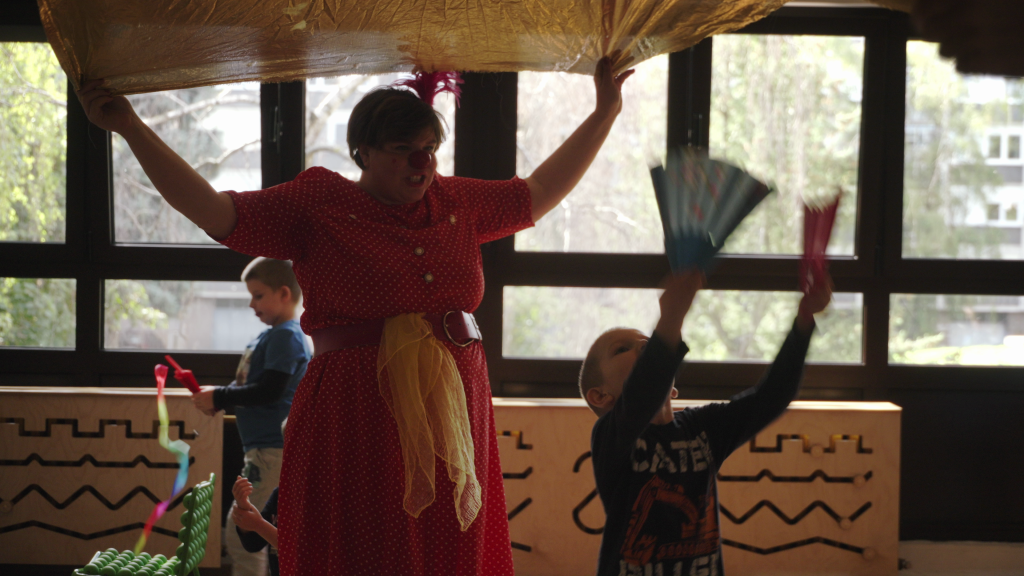
Nina Sabo and Petra Bokić are experienced healthcare clowns working in Zagreb and Rijeka, Croatia, with CRVENI NOSOVI Klaunovidoktori.
The Croatian RED NOSES organisation already had long-standing experience performing for children with disabilities more generally with the Travelling Caravan Orchestra performance, and therefore also a strong network of day centres, kindergartens, and schools that they visited.
Petra had many years of experience with the CarO performance, whereas Nina started performing CarO just after a year of working with the ClowNexus project.
Given the specific focus of ClowNexus on ASD, in the framework of the project, the two worked as a duo, visiting children on the autism spectrum in Bajka Kindergarten and a day care center at the Zagreb Autism Center.
The same Centre agreed to host ClowNexus clowns working with children with ASD from across the project countries as part of the last International Learning Laboratory of the project, in January 2023.
You can read more about this particular laboratory and see some photos from the five-day event in the ClowNexus blog.
The Croatian clowns visited the two institutions monthly, seeing the children for two or three days in a row.
The visits took place over a year and around eight months.
Nina and Petra worked with a teacher and rehabilitator in Bajka Kindergarten to identify two groups to work with, which changed in the new school year.
In the Centre for Autism, they visited all six groups of children going there at the time, seeing some in one visit and others in another. All the children they visited were autistic.
The Croatian artists gathered information about the needs of the children they worked with in conversations with the staff – administrations, teachers, and professional therapists, as well as in reflections between the duo partners and in consultation with the artistic leadership in the organisation.
Learning through exploration – a process that is ongoing for all healthcare clowns but particularly pronounced in the ethos of the ClowNexus project – was a major source of learning for the Croatian artists. In the words of one of them:
“In order to develop a successful collaboration with children on the autism spectrum, it was necessary to learn more about how they perceive the world. Only then can we develop mutual understanding and joyful interaction.”
The clowns initially gathered information on the specific children they were seeing, including names, pictures, progress, and difficulties, and any new developments from the rehabilitators working with them.
After the initial visits, the clowns no longer solicited this information, both to avoid burdening the staff and because they gained new confidence in finding things out for themselves.
Furthermore, the information provided was not always in line with the clowns’ experience of working with the specific children, and it was not helpful for the clowns to be aware of the array of issues experienced by the children in the course of their visits.
The clowns felt comfortable relying on their intuition, which later replaced the theoretical information on the children.
Below follows a description of how the Croatian artists’ work addressed the needs of different target groups, including the clowns and their organisation.
Children with ASD: In an interview on the experience with the CRVENI NOSOVI clowndoctors, Zagreb Autism Center’s director noted various benefits they bring for the children.
She noted the clowns have a way of reaching the children, who open up to the clowns, are happy and relaxed in their presence, and how beneficial this is for their emotional development.
She also noted how aligned the clowns’ approach – their varied means of communication including through touch, gesture, and gaze – is with the centre’s way of working, and how important it is to know that the clowns are exploring new ways to connect with children on the spectrum, a growing group.
Institutional carers: Also from accounts of the Zagreb Autism Centre’s director, the clowns’ work and their relaxing and joyous effect on the children open up space for easier teaching, improving, and adding value to the work of the institution.
Family carers: Family carers, as in most cases when working with children in day care institutions, were not accessible to the clowns as they were not present at the time of the visits.
Clown duo: Through the co-creative exploration and development of their own unique format to work with children with ASD, the Croatian clowns, on the one hand, learned a lot about their universe, but on the other hand, learned to unlearn.
In the words of one of them: “When you think you’ve got it, you understand, you know what to do and how to do it, and get too cocky – the universe will show you that you know nothing!”
Healthcare clowning organisation: CRVENI NOSOVI Klaunovidoktori have among the most experienced clowns in the RED NOSES network, many also with specific experience working with children with disabilities in different capacities.
The ClowNexus project helped to bring more depth and direct specific focus to the project’s target groups and reflection on what works.
In the autumn of 2023, as part of the multiplication of learning foreseen in the project, participating clowns including in the ASD and Dementia tracks, as well as outside lecturers, delivered an organisation-wide several-day workshop focused on sensory clowning and tools.
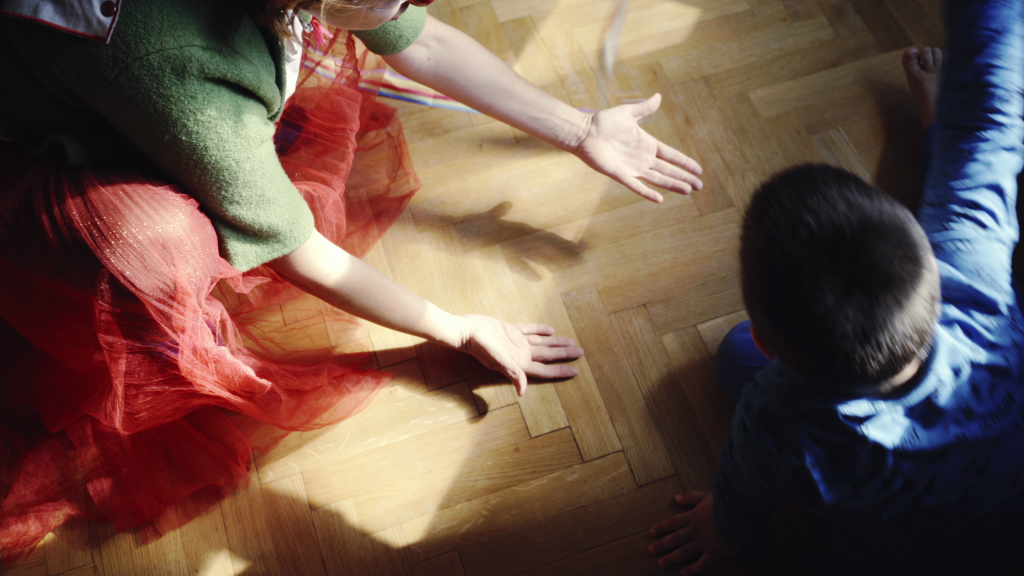
© Mindaugas Drigotas, Berta Tilmantaitė – NARA
The Croatian clown duo used the entrance with a parade and a suitcase filled with musical instruments and other magical objects as the frame for their visits, introducing a variation of different tools within this frame.
Scenario in Focus: The magic, musical suitcase & suitcase of elements
Why interesting: The scenario took as a departure point an existing Red Noses format – Traveling Caravan Orchestra, and maintained several of its elements, including entrance with a parade and a mysterious suitcase housing objects from a theme for that given day.
The suitcase element and the mystery and surprise it represents has the power to create one of those rare connections in such settings for children to all focus on the same activity.
While using a familiar format for inspiration, the participating Croatian artists developed their idea to pilot and incorporate elements from nature and the cycle of life, varying focus between music and sound to touch and feel.
Intention: To awaken interest, disrupt the regular routine, and create a group connection.
Who participates: Children, staff present in the room (rehabilitators), the clown duo.
Duration: Varies for up to 30 minutes.
Setup of the space: The children are in their regular surroundings, each in their own activity at the time the clowns enter, and then focus or drift off freely.
Artistic skills needed: Playing instruments; singing; movement & slapstick; creating with an object; playing with voice and sound.
Props: Suitcase, fabric/scarves; musical instruments; elements to roleplay with – for example, the suitcase of elements contains golden fabric to represent the earth; an egg to represent a seed to be planted; a bucket and bubbles to represent water; and a yellow scarf to represent the sun’s heat needed for the seed to grow.
Description: Clowns enter with a parade, making rhythm and music, carrying a suitcase. They use a simple repetitive “hello song.”
Upon arrival, the intention is to get the children interested in the mysterious content of the suitcase, as there is a surprise in there for all to discover.
In a sense, it’s to get them to focus on one organised activity, huddling for the unraveling of the secret of the day.
The clowns and the children get together as a group, as there is one object that is getting all the attention – the suitcase.
Being together as a group and participating together in the same activity is very rare for the children.
Slowly begins the ritual of opening it – knocking on it, asking if we can open it, the suitcase saying no, and giving different tasks – knock 5 times, clean me with a scarf, blow on me, sing a melody…and then it opens.
Inside are the objects for the theme of the day. Sometimes the suitcase contains musical instruments for the kids to play with; other times it can be filled with natural elements, seeds to plant in the earth, different sensorial objects.
The clowns invite the children to touch and play with the objects, balancing between facilitating the children’s engagement with the objects and letting them freely explore and play with what’s there and the clowns.
Some children like to stay in the group for the duration of the visit, some go about and play for themselves. The staff also participates, helping some children interact with the clowns and objects.
Once the play fizzles out, the clowns put the things back into the suitcase and exit with a song and parade again.
Surprise dwarfs expectation – The clowns realised that rather than having the children ‘prepped’ for their visit and seated and waiting, it’s more organic and less stressful for the children for the clowns to come in naturally and find the kids in whatever they are busy with at the time.
For the clowns, this arrangement is trickier, as they have to redirect each of the children’s attention from their activities to themselves and what they have planned for the day. Depending on the day and group, it is more or less difficult to achieve that.
Likes and dislikes can change – The clowns were careful while developing the scenario and in preparation for specific visits to exchange information with the staff to learn about the individual children, what they like and dislike, possible triggers that may stress them and the like.
This information is important, but may pertain to situations where the given stimulus is by itself, there are also factors like the environment at the time, how the children feel, etc.
For example, staff warned the clowns about some specific children that don’t react well to sounds from musical instruments.
In the environment cushioned with the clowns’ attention and care, however, the children were not only able to engage with the instruments but were sometimes the ones playing the loudest and longest.
The mystery of the suitcase works like a magnet – The suitcase in the clowns’ experience was always a hit when they make it the star of the entrance.
The excitement of the suitcase each time the clowns visit and knowing they will play with the things inside it worked assuringly for the children each time, drawing their attention to the object and the clowns’ activity.
At the same time, once used in this way, the suitcase object is always met with the same expectation, as it is no longer possible for the clowns to incorporate a suitcase as a simple container for things they bring.
The predictability of the suitcase routine is also broken when it contains other than the things that were originally there.
Interesting to explore the connection between the children even more – The clowns would like to try out, in the scenario with musical instruments, bringing one of the same instruments for the same group.
This would for one preempt children not being able to each get the instrument they want, and could potentially be more cohesive to bring the group together.
When working with natural elements, the clowns feel they can go even further into the explorations with natural elements and the life-cycle theme to, for example, actually plant seeds in soil, water them, and leave the garden for the children to watch grow.
Shiny things are okay – The Croatian artists at times wondered if all the shiny, exciting things they bring each time on their visit possibly detract attention and come at the expense of less connection between the children and the clowns.
Having discussed this with staff in the visited centres, they learned that for some children, especially, an object that a person has may be the only way to connect with that person.
Less abstract is more – Explorations with different scenarios, of which the Croatian duo tried many, brought the realisation that clarity of intention – and the tools matched to achieve it – is important when working with children on the Autism spectrum.
Piloting the idea of planting a seed in the earth with the use of symbolic objects, the clowns found the chosen theme and materials were too abstract for the children to connect to.
© PIROS ORR – Vera Éder
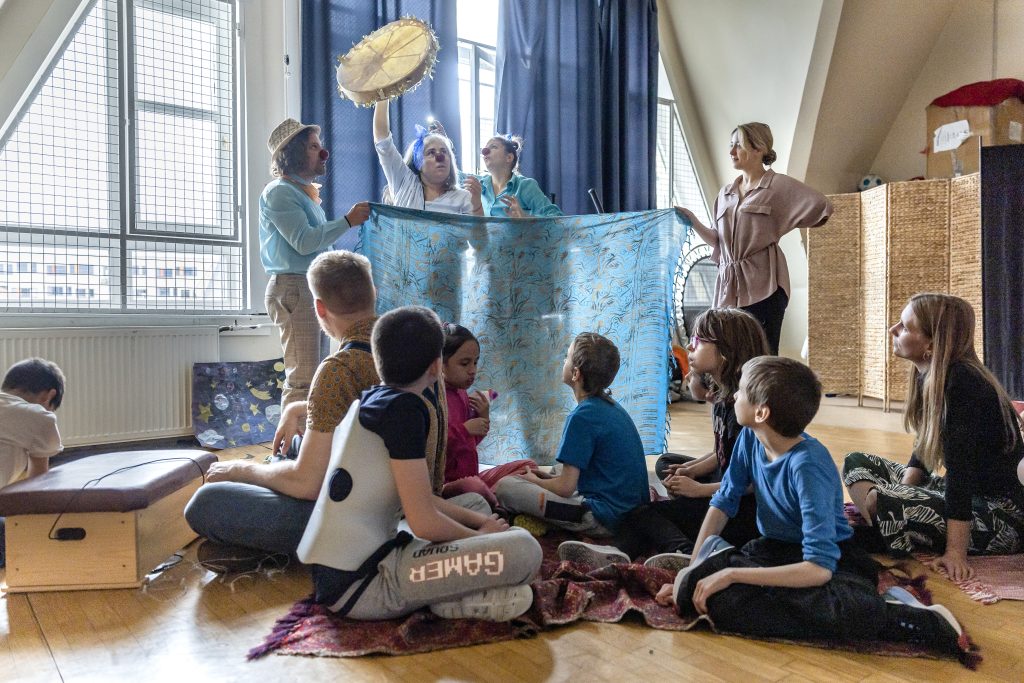
Andrea Gerle and Roland Mangold are experienced healthcare clowns working with PIROS ORR Bohócdoktorok, the RED NOSES healthcare clowning organization in Hungary.
Andrea boasts 18 years of clowning experience, while Roland has 8 years under his belt. Both artists operate in and around Budapest.
During the ClowNexus project, Andrea and Roland teamed up as a duo, focusing on visiting three specific classes of children at a school specialising in working with children with disabilities.
These clown visits occurred monthly, consistently taking place during the morning circle routine.
Before ClowNexus, both artists regularly performed a clown show for children with disabilities, known as the Travelling Caravan Orchestra or CarO.
This show was the primary method for engaging with their target group in general, and more specifically, with children with ASD.
As part of the ClowNexus project, the artists embarked on developing their unique approach. They initiated this process by reflecting together, consulting with artistic leadership, and collaborating with the staff and teachers at the selected school.
The chosen school was a long-standing partner that PIROS ORR clowns had visited with the CarO performance.
Even before ClowNexus, the Hungarian clown artists felt the need to support the teachers by delivering a workshop, sharing clown tools and approaches.
These initial workshops laid the foundation for broader discussions related to the ClowNexus project, and they served as a precursor to the deeper collaboration made possible by ClowNexus.
A series of workshops followed, organised both by the school and PIROS ORR, and not limited to the participating duo, allowing other clowns to engage in these learning sessions.
Furthermore, the teachers actively participated in workshops held by PIROS ORR, facilitated by Andrea and Roland.
As a culmination of their partnership under the ClowNexus project, the clowns, together with the teachers, co-created the final closing events.
Within the selected three classes, the clown duo worked closely with the teachers, helping them understand the structure of the clown’s scenarios and how they could facilitate the activities.
To prepare the children for the clown visits, the teachers included the clowns’ pictures in the calendar on the day of their visit.
The clown duo maintained the regularity of these visits and, in cases where they couldn’t attend due to travel for ClowNexus International Learning Laboratories, they sent postcards to remind the children of their commitment and presence.
To assess the needs and impacts of their work, the clown duo conducted pre- and post-visit debriefs with the teachers.
Before each visit, they would inquire about the latest developments with the children in the classroom.
After the visits, the debriefs aimed to discuss changes observed, reflect on what worked well or less effectively, and understand how to interpret the children’s reactions to the clowns within the context of their regular participation levels.
Children with ASD: The clowns brought a playful energy to the part of the day when they visited.
Through their interactions with the children and discussions with the school staff, they observed how their presence helped re-engage children who had trouble focusing or encouraged children who tended to isolate themselves from others to participate in teamwork activities.
The artists aimed to create group cohesion in the classrooms, and based on their observations and feedback from the teachers, they succeeded in achieving this.
The clowns also successfully taught the children not only the clown language but also humour, with the children increasingly initiating their jokes.
This, according to the artists, was a valuable skill, especially for the higher-functioning children.
School Staff: Through the co-creative approach of the ClowNexus project and the clowns, the school staff became key partners in developing the clown format.
Besides observing the children in a different context during the clowns’ visits and sharing the emotions of those visits, some teachers received workshops from the clowns and conducted workshops for them in return.
This mutual exchange allowed them to gain insights into working with children in general and children with ASD in particular.
Family Members: Although the clowns did not directly engage with the carers of the visited children, they learned about the needs of family carers of children with ASD through discussions with the school staff.
These discussions revealed that parents placed importance on their children’s access to culture, although the existing offerings, such as traditional theatre for children with ASD, presented accessibility challenges.
Clown Artists: Andrea and Roland acquired the knowledge and confidence to work with children with ASD, developed sensitivity to their needs and reactions, and improved their ability to recognise and incorporate feedback as part of the co-creative process.
Like all clowns in the ClowNexus project, they became their own artistic directors, fine-tuning a valuable and unique format.
One of the clowns aptly put it:
“As the kids improved, so did we. Their advancement inspired us to be ‘braver’ to do even more. This, however, requires a long-term commitment and presence.”
Healthcare Clowning Organisation: Before ClowNexus, PIROS ORR primarily used CarO as the main approach to working with children with disabilities.
As a result of the efforts of the clown duo in understanding and exploring what works with children with ASD, the organisation adapted its Travelling Caravan Orchestra format.
This adaptation included actively seeking opportunities to perform exclusively for groups of children with ASD. The exchange of workshops between the school and PIROS ORR, involving other clown artists and school staff, further enhanced the capacity to understand and work with children with ASD.
Notably, the workshops included frontline staff, such as teachers, rehabilitators, and healthcare clowns, providing them with a platform to share their experiences.
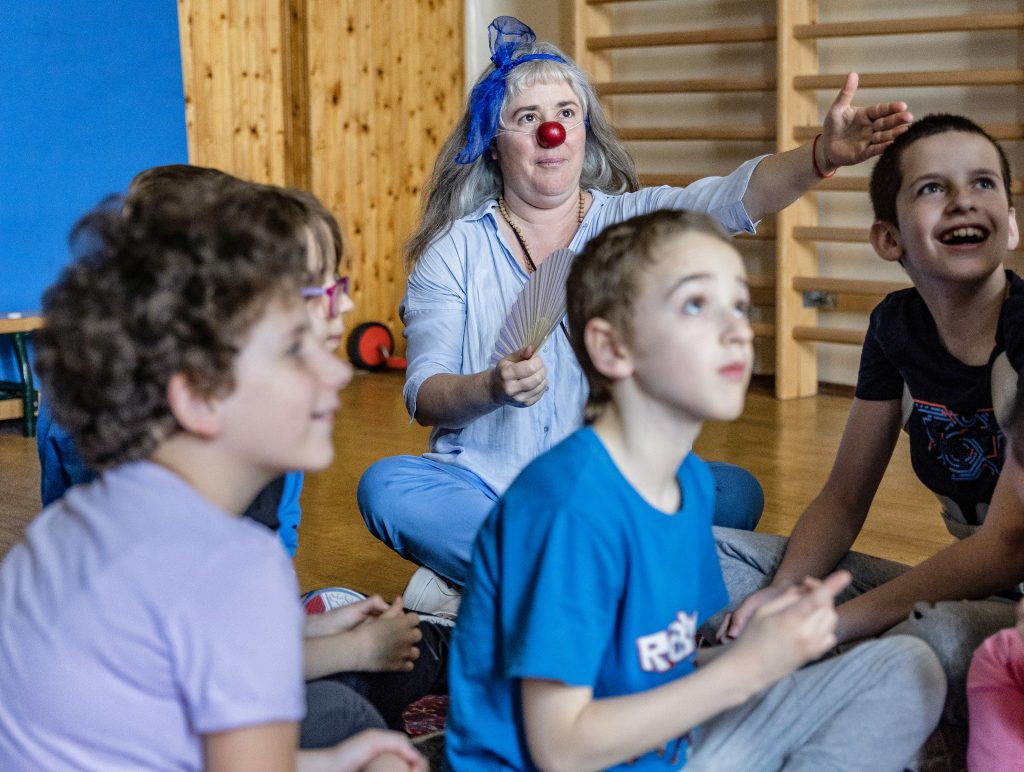
© PIROS ORR – Vera Éder
The artists utilised the dramaturgy and structure of CarO as a starting point for developing their unique format.
They retained elements such as the parade-like entrance, the use of sensorial objects, and slapstick comedy even after crafting their approach.
An example of one of their tools in practice is presented below.
Clown Participation in Class Why it’s interesting: In this scenario, the clowns serve as an outside presence within the classroom, enriching the classroom experience for both the children and the teachers.
They effectively become a regular fixture in the classroom without detracting from organised activities, thereby enhancing social interactions and participation among the children.
Intention: The clowns aim to diminish any fear that some children might have of strangers, and to improve the children’s social skills, such as sharing and following rules.
Natural elements are incorporated to elicit sensory responses and introduce the children to topics such as the seasons, integrating learning and play into the curriculum.
Participants: Children in the classroom, the clowns, and teachers and other personnel present at the time.
Duration: 1.5 to 2 hours
Setup of the Space: Clowns enter the classroom and move through different “stations,” from the door to the tables, eventually inviting the children to sit on a rug.
Artistic Skills Needed: Attentive listening, movement, creating with an object, roleplay, musicality, rhythm.
Props: Rug, natural elements like leaves or bread dough.
Description: The scenario involves a progression of clown presence in the classroom.
The clowns begin by entering the classroom with high energy (ranging from 80-100%), which gradually decreases to 20-30% to seamlessly integrate into the morning circle without disrupting the class dynamics.
Despite toning down their clownishness, the clowns maintain their openness and playful attitude during this phase.
They participate in the same activities, lessons, and rewards as the children, subtly infusing an element of playfulness to engage the children more actively.
The scenario then transitions to a free time for the children, during which the clowns adjust their energy levels between 20-50% depending on the type of engagement and the children’s energy levels.
The clowns introduce a tool they refer to as ‘A rug!’, which involves placing a rug in a specific area of the room.
This simple act naturally gathers all the children on the rug and focuses their attention on the clowns.
On the rug, the clowns employ various sensorial tools, including natural elements aligned with curriculum topics.
During this phase, the clown energy levels decrease to around 10%, allowing the content of the day to take precedence.
The visit concludes with another burst of energy, ramping up to around 60% clownishness, as the clowns joyfully bid farewell to the class.
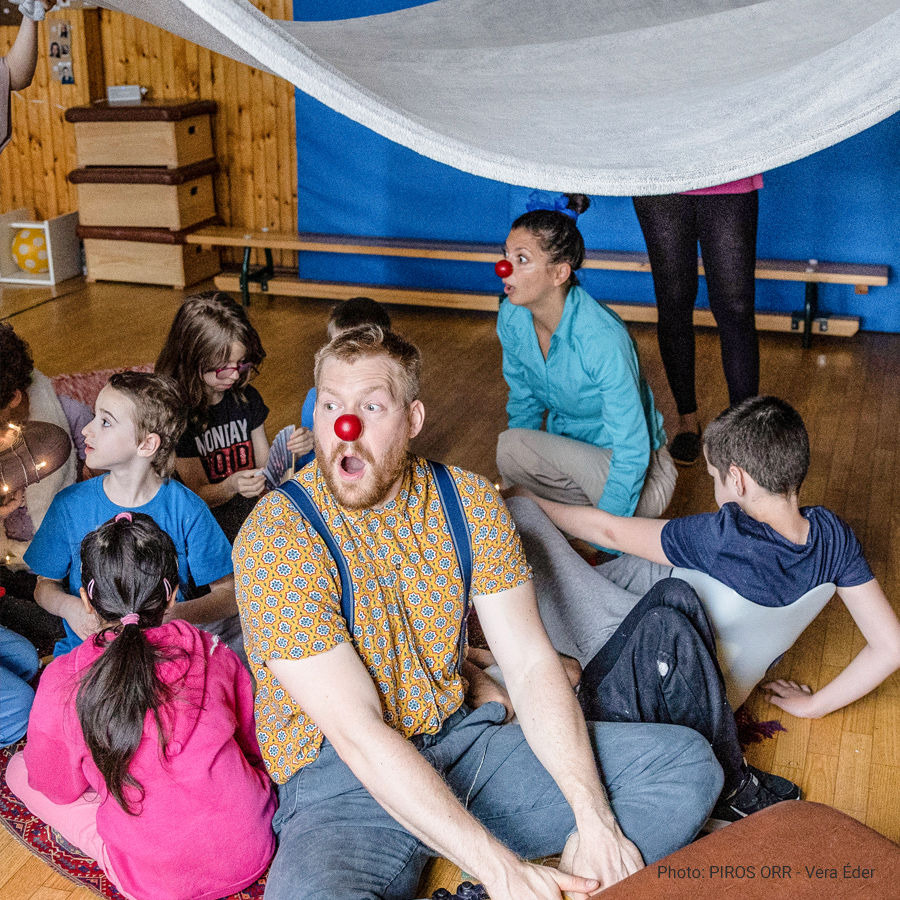
© PIROS ORR – Vera Éder
Need to Connect Parents: The clowns recognised the need to establish connections with parents.
Their initial exploration sought to bridge the gap between families and their children’s clown encounters, with the aim of allowing them to share the experience and its benefits.
Cooperation with Teachers is Vital: The clowns acknowledged the significance of building rapport with teachers as a prerequisite to creating an effective partnership and ensuring the success of their work with the children.
Clowns as Connection Enhancers: The Hungarian clown artists expanded their understanding of the value clowns bring.
Rather than focusing solely on predefined ‘formats,’ they began to view the clown itself as a tool for enhancing connections between people.
This change in perspective allowed them to use their clown personas as instruments of connection, leading to more profound and meaningful interactions.
© Saulius Aliukonis
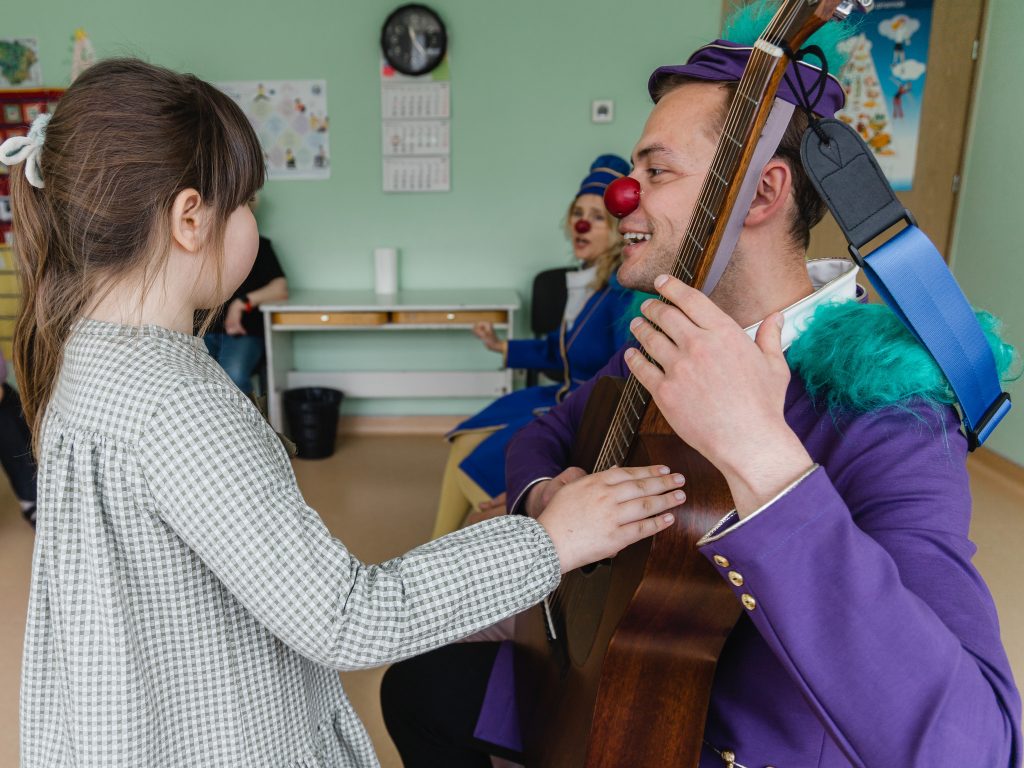
Previous Experiences
Indrė and Žilvinas are healthcare clowns with 13 and 11 years of experience in clowning. Indrė is the Artistic Director of RED NOSES in Lithuania “Raudonos Nosys”. Both have had exposure to working with children with disabilities during hospital visits and when performing the interactive theater play, “The Traveling Caravan Orchestra” (CarO) in schools.
However, until ClowNexus they did not focus specifically on expanding their capacities and know-how about working with children with ASD.
ClowNexus provided an opportunityto get to know this group of children better as well as the possibility to work with the same group of children for several weeks at a time – not a common scenario for healthcare clowns who often meet people during one-off encounters.
Throughout the first part of the project, this clown duo started reading about ASD, meeting with teachers, experts and organisations to understand the context of the field. During their visits to hospitals, the pair started exploring the specifics of working with children with ASD.
They began to explore concepts on how to creatively involve the senses. Indrė and Žilvinas felt comfortable with the amount of time and room available as part of the project to ease into this venture, explore artistic tools, and get to know each other more.
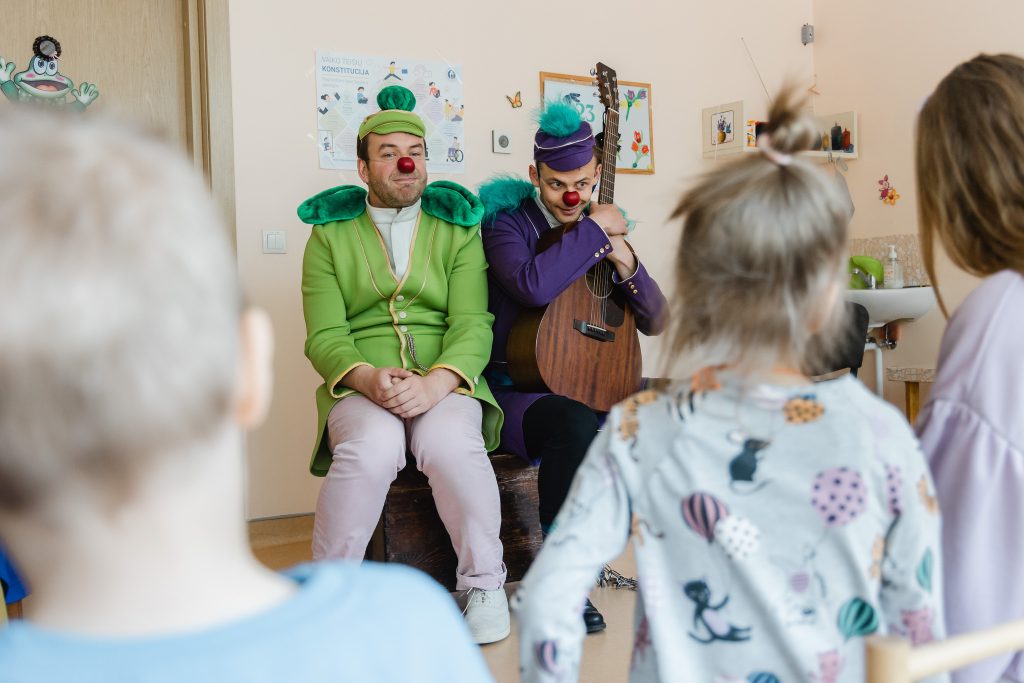
© Saulius Aliukonis
Partnership and Communication with School
Indrė and Žilvinas started exploratory visits to special schools, and chose to work with one special school in the city of Vilnius. With both artists based in Vilnius, weekly visits were possible.
The duo selected this school based on a previous successful cooperation – Raudonos Nosys had been performing the Traveling Caravan Orchestra there for a couple of years before ClowNexus started. The onboarding of the school into the programme was very smooth, and Raudonos Nosys signed a cooperation agreement with them.
The participatory activities started in the autumn of 2021 and lasted until summer 2023. The focus was on one class per school year.
During theyear, roughly 10 visits to a class took place, and in the second year there were over 15 visits. The visits lasted between 30-35 minutes each. Both classes had around seven children, most but not all of whom had ASD.
The classes selected to visit were chosen by the school – Raudonos Nosys and the duo were in touch with the administration, who based the selection on a description of the project, the wish to engage with children with ASD and the needs of the children themselves.
After the classes were selected, the clown duo collaborated directly with the teachers. The duo were in close communication with them, both before and after visits, verbally and in writing.
Before the visits, the artists were provided with information on the specific children, any developments related to their wellbeing, and who would be present/absent during the visit; the artists also shared any new things they learned about working with the children.
After the visits, the artists would conduct a check in and the teachers would share how the group was feeling, exchange thoughts on the children’s reactions, what worked, what could be done differently.

© Saulius Aliukonis
Preparation Before the Visits:
In preparation for the initial visits and to help the children prepare for a new presence in the classroom, the clowns prepared a video for the children.
In the video, the clowns presented themselves, explained what they would do together, showed the props they would use, suc as the luggage that would be in focus every visit.
The children also received photos of the clowns that were pinned to the board on the calendar to show they’d be visiting on Mondays.
Even on the Mondays when the clowns couldn’t be present, e.g. due to the international laboratories organised in the frame of ClowNexus, the children would go and point to the pictures meaning they’d become a usual part of their routine.
The duo identified the needs of the children through their research on ASD, experience in the different artistic laboratories and materials developed in the ClowNexus project, as well as through conversations with the teachers and through observing the children’s reactions during initial visits.
The children were mostly non-verbal so observing the needs and how they are met was key.
Children: A particular need identified by the teachers was that the children spend a lot of time sitting, and it would be nice for the clowns to find something more interactive to get them to stand up.
The teachers also identified needs of specific children in the group ad hoc as they would arise, e.g. to support a child to come out from under the table.
During the duo’s work with the children, the clowns, carers and parents observed various changes among the children visited including:
Some children overcame fears – a girl who is generally afraid of men and would not let the male clown interact with her during initial visits later warmed up to him; a child who was prone to hurting himself and would leave when the clowns came really got into sharing in the moment through the play with animal hats.
Parents/carers: The parents, who were not present during the visits, expressed interest in what happened when the clown duo was with the children, and asked to see photos from the visits.
As in the example above, parents also have a need to find more channels to connect with and stimulate their child’s development and see their progress.
The teacher from one of the classrooms shared videos and photos with the parents so they could learn from the clown visits, which the parents appreciated.
The parents also shared, after seeing videos, their surprise regarding the clowns ability to connect with their children as if they’d known them for a long time.
Teachers & other institutional staff: As pedagogues working with children with ASD, the teachers did not explicitly formulate their own needs that could be supported by the clowns’ work.
However, the duo identified certain needs of the teachers, such as being meaningfully included in the activities of the clowns.
The artists also saw a need for the teachers to really understand the role of the artists and how to react to them, reminding them that the clown artists are professionals who do not need to see the children on their best behavior.
The feedback from teachers participating in the visits was very valuable, as they know the children very well and were able to identify new capabilities and reactions of the children.
Teachers also felt needed because despite the connection the clowns were able to make with the children, the kids felt safe having the teachers present and partaking in the dynamics offered by the clowns.
Clown duo: The artists needed information about the children they would be meeting, and an understanding of the do’s and don’ts.
They were also keen to build a rapport with the teachers, who would feel safer with the clowns the more they know about their work.
For one of the participating artists, children with ASD were the most challenging group to come across during hospital or CarO visits, so there was an evident needfor them to work on their own skills and gain experience in engaging with this group of children.
For both of the clowns, there was also a need for something new in their usual routine of predominantly hospital, usually one-off encounters. The possibility to focus on one specific topic/target group was also welcomed.
Being able to connect to the same group of children during the weekly visits was a big motivating factor and provided a source of meaning to the artists.
One of the artists overcame their initial nerves concerning meeting children with ASD. They also gained confidence in their knowledge and skills working with children with ASD and now feel comfortable sharing this knowledge with other artists in their organisation.
Importantly, they gained the confidence and ease to really play, have space for something to happen with the children they meet, without the fear they may not succeed, and with the comfort to accept when they don’t.
This experience made them enjoy their work more, and get recognition from other clowns they work with about changes to their approach.
Healthcare clowning organisation: Raudonos Nosys and the participating duo had their own personalised goals to give meaning to the work they were doing.
Raudonos Nosys is currently developing a new format for children with ASD based on the experience of the ClowNexus proejct and the Traveling Caravan Orchestra – a format that has been used for a long time working with children with disabilities.
The organisation has consolidated know-how on working with children with ASD, and the clown duo has become the source of knowledge, sharing their experiences during workshops with their colleagues.
Now, there is an increased atmosphere of sharing and support within the organisation by virtue of having these ‘ambassadors’ who are able to inspire as a result of their authentic experience.
The duo used a variety of artistic tools including psychical comedy, ritual songs, and role play in animal hats. They included teachers in the play, made efforts to pay personalised attention to each child, and were sensitivite with their use of language.
Scenario in Focus: fairy tale Play
Why interesting: The focus on a coherent story teaches children to concentrate and follow the plot. Each child can find something that speaks most to them.
The frame of the story gives artists and children alike the safety and structure to improvise, and think on an abstract level, as you can always return to the story.
There is also a meta-level here whereby the clown – already a character – is playing a character in the play, empowering children to also try roleplaying.
Intention: To play a fairy tale with the kids
Who participates: Clowns and kids
Duration: 30 minutes
Setup of the space: Artists use a fairy tale as a basis for their clown play. Clowns jump into different roles, kids join them or help through actions.
Artistic skills needed: Story-telling, music, movement
Props: A suitcase, animal hats (for different roles), some other objects that can be used for development of the story
Description: The duo underwent two phases in their work – connecting and later jumping into the fairy tales.
Phase 1 – Connecting consisted of preparatory work described in the setting. During the initial visits with the kids, the duo explored playing with different objects, singing, dancing and seeing what worked.
While they initially brought all objects to play with, the duo eventually would only bring 1-2 in their magic suitcase to focus on in the visit – for example a glove, which is a central object in a traditional Lithuanian fairy tale about forest animals finding refuge in the glove.
The goal of reducing the number of objects was to achieve more concentration and focus.
Phase 2 – Jumping into fairy tales: Once everyone in the group felt safe, the duo started to introduce the world of fairy tales, hailing from their exploration in Lithuania with drama therapy.
The duo took inspiration from the fairy tales they read as children or with their kids, and focused on animal characters.
The fairy tale play structure consisted of:
On Clowning
Timing is key
The artists found it helpful to have continuous visits to connect with a group of children with ASD. Being able to connect with the children during multiple visits made it possible for the artists to build relationships step-by step.
Developing this relationship was necessary to both better understand the children’s needs and to achieve more during the encounters. Stronger relationships also enabled the artists to ease into a new format of clowning, whereby clowns can slowly build up to having an impact rather than having to achieve a lot during a one-off visit.
Likewise, it took time for the clown duo to get into an exploratory mode to try out and finetune what would work with this group of children.
An important lesson for the artists was not to rush with solutions during the performances, to give themselves time and manage expectations. They needed to accept that it wasn’t always possible to succeed in making aconnection with each child and rather give themselves time to react to situations as they arose.
Familiarity and predictability
After the initial explorations of placing different objects and tools in the center of the visits, the duo realised it became easier for them and the children once they settled on the fairy tale format.
This familiar format, including the sequence of how the story was introduced to the childrenand brought back into the suitcase it came from, provided safety for all involved as it was familiar.
Using a familiar format made it possible to focus on a new story/object during each meeting, while still respecting the steps and structure already known to everyone.
At the same time, the duo learned that without the initial exploration of a variety of objects, they wouldn’t have developed the approach to focus on just one.
Role-play as a mobilising agent
In line with the need identified by the teacher for the clowns to explore how to get children more physically active during the meetings, the clowns reflected on the fact that storytelling is often more of a sitting activity.
However, they learned that by inviting children to perform the story by putting on animal hats, the children started jumping into character and participating, also physically.
Seeing the clowns in character also empowered the kids to try and spontaneously do things they otherwise would not.
The clown vulnerability is relatable for the children and acted as a door opener, especially for children with specific sensitivities.
Intent in choices related to language
The clown duo observed, through their exploration with the fairy tale and other tools, that language is a good connector when used with clarity of intent and scarcity.
They used ‘ritual language’ like repeating words and phrases, and maintained the dynamic of continuing and ending with what you introduced in the beginning.
For example, the artists in the beginning of a visit sang a song about body parts. The teachers asked the clowns to get the children moving and make them stand up.
The clowns started with small greetings to the body parts they sang about until they got to bellies and behinds. The children then started to stand up and dance with the clowns. The teachers were very happy.
The clowns were conscious of the words they already used in a given visit, and by using expressions – always going for the simple to understand and easy to repeat – would mention similar things with similar meanings.
Likewise, the accompanying emotion, sometimes more than the language as not all the children were verbal – has to be clear and have a clear intention.
On work with institutions
Clarity about the roles and expectations of the artists – the artists had a different experience with the two classes they worked with.
The first class was selected based – to some extent – on the abilities of the children, whereby the school was maybe more comfortable introducing the clowns to a group where children have less special needs.
Likewise, the teacher was always active in trying to get the children to behave, worried about making a bad impression or creating a difficult experience for the artists.
It took time to build the rapport needed for the school to trust the artists with an unpolished experience with a group of children, and for the teacher to feel comfortable with the fact that no matter what the children did, the artists were professionals and would manage without intervention.
Taking risks pays off – as with the Travelling Caravan Orchestra format, the visits of the clown duo always took place in the children’s classrooms – with the intention to keep them in a familiar setting. Beforehand, there had been little to no variation to this policy due to the assumption that it’s the best for the children.
For the ClowNexus project and the documentary that was developed to share its learnings, there was a need from the camera crew to move into a much bigger space – the school’s theater hall.
This space was much more suitable for the visits and facilitated much more physicality, giving more of a special occasion feeling to the visits.
This learning inspired the idea to invite the children to a real theater experience with the new format, taking them out of their classrooms and later out of the schools altogether, as there are little accessible theater experiences for children with ASD in Lithuania.
© Lisa Baxter
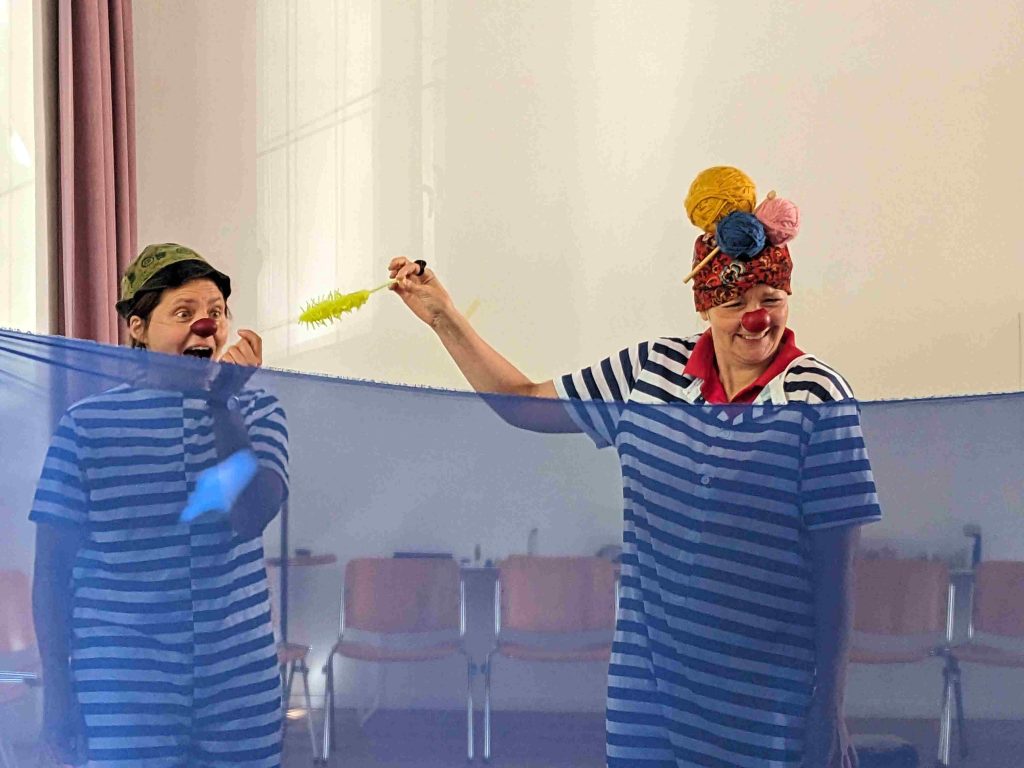
Elina Reinikka and Katja Lehtola are healthcare clowns associated with the Finnish Hospital Clowns Association, Sairaalaklovnit ry, operating in the regions of Helsinki and Oulu.
They were selected to participate in ClowNexus to explore clowning approaches for autistic children.
Aligned with the Sairaalaklovnit approach of disseminating learnings to the entire association, the duo collaborated during international artistic laboratories, engaging in joint co-creation and exploration of approaches and tools for their visits with children.
However, they worked independently in their respective regions. Clowns in Tampere also implemented interventions for children with ASD in similar settings, exchanging learnings throughout the ClowNexus project, even though they were not part of the international collaborative learning.
Unlike experiences in most countries, where clown artists working on approaches with children with ASD visited day centres, schools, and kindergartens, and similar to the approach of Pallapupas (ES), the Finnish clown artists worked in hospital neurological departments and hospital rehabilitation units for children with disabilities.
Their unique approach involved accompanying children in the medical evaluation and testing process to determine an ASD diagnosis.
In Helsinki, apart from working with individual families during the diagnosis process, the clowns piloted multi-sensorial performances for families once a month, approximately five times under the project.
They visited Day Center Vuori in the neurological ward of the New Children’s Hospital 12 times, accompanying children through the three-day diagnosis process.
The clowns worked separately, each accompanying a child’s process, from meeting the family upon arrival to participating in various research activities.
They closely collaborated with the child’s nurse, scheduling visits, and participating in most examinations, except for some neuropsychological studies conducted without the clown’s presence.
In Oulu, participating clown artists, Katja Lehtola and a partner, collaborated with different institutions for ClowNexus research and visits.
They visited a rehabilitation unit once or twice a month, conducting around four-hour clown visits along with information exchange before and reporting after the visit.
They also visited a neurological ward in a hospital, following a similar ASD research procedure for diagnostic purposes as in Helsinki, albeit with less intensity.
The clowns accompanied the child and family for 1-3 days during their free time between appointments or playtime with the nurse, performing the forest trip performance described in the scenario below.
The Finnish organisation and clown artists employed various tools to understand the needs of children, their families, and the staff in the ASD wards of the hospital, as well as of the healthcare clowns themselves.
Additionally, they collaborated with instruments used by partner institutions.
For instance, in Helsinki, nurses commonly utilised the “PEP-R” (Psychoeducational Profile-Revised), a test developed in the USA to assess the developmental level and behaviour of children with autism and other communication difficulties aged 1-7.
The areas tested include imitation, perception, fine motor skills, gross motor skills, hand-eye coordination, and verbal and non-verbal cognitive function.
The evaluation also covers the manifestation of abnormal behaviour in interaction, emotional expression, play, interest in objects, sensory reactions, and language use.
Notably, the PEP-R is designed for use as a basis for individualised rehabilitation programmes and is specifically tailored for testing autistic children who may be challenging to assess with traditional methods.
In the New Children’s Hospital, the head nurse of the ward, along with the nurse assigned to a specific child, pre-determined which children could benefit significantly from clown support.
Among the selected children, all families accepted the clown support and participated in the pilot.
While some families initially felt uncertain and reserved, the interactions with the clown artists proved to be a positive source of support for all families.
Children with ASD – The children who received visits encountered humour, enjoyment, and playful associative journeys within a highly structured process that necessitated adherence to instructions.
According to feedback from the staff, the prestige of the ASD ward in the Helsinki hospital improved due to the collaboration with the clowns.
The presence of the clowns supported the research process for diagnosing ASD, with their approaches seamlessly aligning with the work of other specialists.
The clown’s intervention was shaped in collaboration with the nurse, speech therapist, occupational therapist, and doctor, depending on the situation.
Nurses linked the clown’s play with experiment-related objects, suggesting various approaches. At times, the clown served as an encourager, while at other times, they tested limits.
The occupational therapist might propose activities like playing with a ball or jumping on one leg, and through play, the clown assisted and encouraged the child to attempt the activities, providing the therapist with necessary information about the child’s motor skills.
Nurses particularly appreciated performances where the clowns engaged with families and children together, offering the first opportunities for such interactions since the COVID-19 pandemic.
The work conducted under ClowNexus transformed the relationship between Sairaalaklovnit and the partner hospital.
The clowns continue to visit the neurological ward for one hour every week, maintaining monthly multisensorial shows for children, families, and staff—a new initiative since the project.
The weekly visits are pre-planned, and nurses, now familiar with how the clowns work, optimise this time by setting up situations they want the clown to participate.
The hospital and the clowns are also experimenting with a clown-on-demand system. Here, a nurse can schedule a clown for a visit the following week, observing playtime between the child and the clown in the presence of parents.
This facilitates understanding of the child’s interactions and communication, allowing nurses to instruct parents based on the observations.
With the clowns, the children enjoyed the freedom to play according to their own rules, engaging to the extent they desired.
The clown artists observed numerous benefits for the children, noting their enthusiasm during activities, their ability to control engagement levels without withdrawing from play, and other positive outcomes.
Institutional carers
Family carers – For family members of the visited children, clown visits alleviated some of the stress associated with the ASD diagnosing process.
The activities proposed by the clowns transported them to a different place—a serene forest or seaside trip—with all the organic associations it brings.
Families also had the opportunity to experience monthly performances where clowns brought together families undergoing the diagnostic process.
A neuropsychologist working in the ASD ward mentioned she could observe different situations in the performance, noting children’s reactions and their connection with their parents.
This made her proud that their ward had a monthly clown performance. During feedback sessions with the clowns, families expressed that returning to the hospital after their children experienced the clown visits was easier, associating the hospital with the positive moments they shared with the clowns.
The clowns also proved valuable for parents during various medical examinations. For example, some children were particularly sensitive to having their ears tested, and the accompanying clown was perfect to help with that.
Clown artists – The clown artists bore the dual responsibility of creating the beautiful scenarios developed to engage with the children while also functioning as researchers, actively observing, learning, and analysing their experiences throughout these interactions.
In addition to scenarios involving multiple children, such as the forest trip described in the focused scenario, they employed diverse approaches when working with severely autistic children.
Recognising the breadth of the spectrum, the clowns honed their ability to discern and appreciate the numerous signs indicating that children were connecting with them—manifested through their cooperation and excitement.
One clown, for instance, recounted witnessing a girl rushing out of the scenario to share the unfolding events with her dad before eagerly returning inside.
This display of emotion, empathy, and other abilities might not have been captured by the nurses had it not been for the clowns’ presence.
Healthcare clowning organization – Before ClowNexus, the Sairaalaklovnit clowns regularly interacted with children with ASD and visited neurological wards.
However, as an organisation and individually, they lacked specific knowledge about children on the autism spectrum and did not possess dedicated tools or methods to approach or connect with these children.
ClowNexus has brought about significant changes in how Sairaalaklovnit engages with this target group.
The collaboration with staff in neurological wards has also seen a substantial increase and intensification, as staff members now understand how to leverage clowning to support children during their hospital stays.
The work of Sairaalaklovnit clown artists under ClowNexus underwent evaluation in a report titled “Healthcare clowning for child patients” by the Finnish Institute for Health and Welfare (THL), published in 2023 (available here).
This peer-reviewed report highlights ClowNexus and the efforts of Sairaalaklovnit in working with children with ASD. Healthcare clowning was assessed as an excellent, evidence-based, child-oriented, and effective practice.
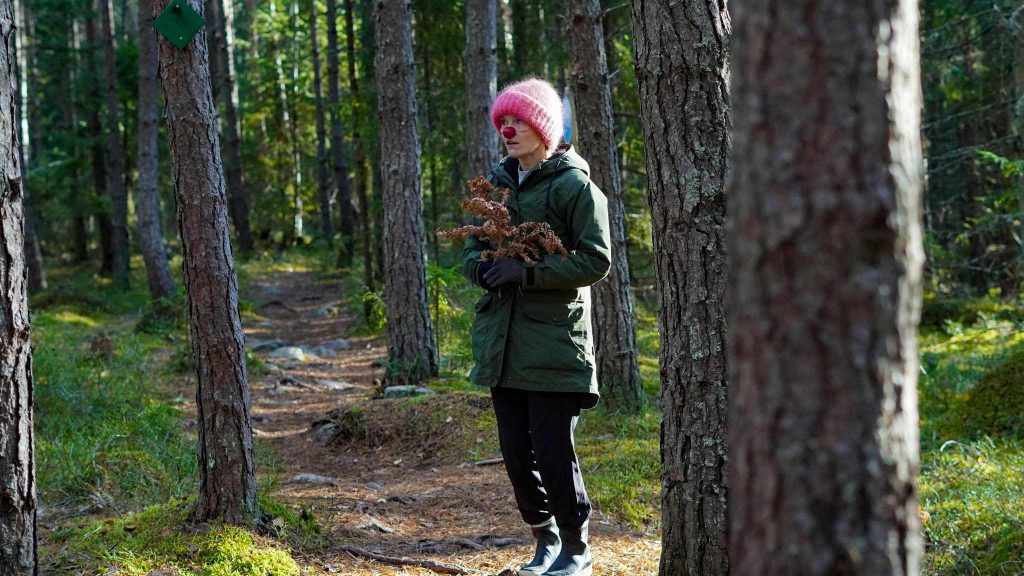
© Sairaalaklovnit
The Finnish clowns experimented with a variety of tools, often involving creation with objects and a focus on the senses, whether in the context of a seaside adventure or a forest trip—a scenario specifically developed during ClowNexus, detailed below.
Forest simulation trip – A mix of various sensory tools
Why interesting: This scenario showcases a wide range of sensory simulation-focused tools explored by Finnish clowns, emphasising the theme of immersing children in nature or providing an organic experience in a controlled and sterile hospital environment.
Intention: The clown artists integrated the tools to provide sensorial stimulation for the children.
Beyond visual stimulation through a simulated forest environment in a hospital room, the children are invited to touch and smell the nature it contains and feel different textures and sounds.
The clowns also aim to spark the children’s curiosity and surprise them with elements not typically encountered in a hospital setting.
Participants: The clowns facilitate the forest experience, with around five children participating, and family and hospital carers are also welcome to join in.
Duration: 20 minutes or longer, depending on the number of tools applied.
Setup of the space: The clown artists prepare a room in the ward, adorned with gifts from the forest, where the children embark on a journey from their rooms to this forest room—the ward’s larger playroom.
Accompanied by the clowns, the children experience dimmed lights and forest voices emanating from speakers, with tables and chairs arranged to the walls to leave space for interaction with items brought out by the clowns.
Artistic skills needed: Creating with an object; playing with voice and sound; movement & slapstick.
Props: Various items from the forest to recreate its appearance (green forest blanket, shrubs, moss to decorate the room), smells (e.g., pine scent jar, wood/bark), textures (bags of leaves, pine cones), and sounds (speaker, forest sound playlist).
A small makeshift cabin helps create a feeling of protection and safety in the forest environment.
Clowns also dress up in apparel fitting for a forest trip and bring additional props like little forest animals (one clown had a hedgehog named Mehve), fabrics, binoculars, etc.
Description: The duo starts their visit from the corridor, entering the department with a song through a forest blanket, wearing ponchos and rain boots, with binoculars in hand to direct attention to specific things to look at.
The clowns then use various forest-inspired tools they developed. Mehve the hedgehog, handled by one of the clowns, engages with the children to encourage them to interact with the different objects focused on in the play.
The bag of leaves, made of thin transparent cloth and dry leaves, invites children to touch and play with it as they please.
Some children may be cautious or startled by the sounds of rustling leaves, while others throw them around in excitement. The scent jar, a small bottle with pine essential oil tied on a little rope, is handled by a clown who brings it to children interested in smelling it.
Children are free to engage with or ignore the objects, opening doors to various themes and plays.
In addition to these tools, the Finnish clown artists incorporated various others, combining them into the full experience of the forest trip.
The trip concludes with everyone reaching the “river”—a big cloth the kids can dive into, accompanied by sounds, with the clowns waving the cloth above the children lying on mattresses on the floor, rolling and “swimming” around.
The Finnish clown artists have devised various innovative organisational tools to support their artistic work in hospitals, as detailed below.
Reporting clown visits in the medical journal as a useful innovation:
In the spirit of co-creation and to maintain a track record of clown visits accessible for family and medical professionals, the clown artists collborated with the ward’s contact person.
Together, they reflected on and documented each child’s reactions and interactions with the clowns in a medical journal.
These observations inform the rehabilitation process, allowing children to revisit memories of the clown visit, recall their feelings, and build excitement for future visits.
Additionally, it enhances accessibility for the staff.
Clown user manual:
Another notable innovation is the development of a “clown user manual.” Initially, a clown accompanied a child’s hospital stay during the ASD diagnosis process, funded by ClowNexus.
However, after the project concluded, this arrangement proved resource-intensive.
To continue supporting staff and working with children, Sairaalaklovnit introduced the concept of “clowns on demand.”
They created a manual for the staff, offering ideas and inspiration on when to enlist the clowns’ help.
Clowns would be available for one hour weekly, and the ward could plan when to book this hour.
Given the staff’s prior experience with clown visits during ClowNexus, this arrangement proved effective.
For additional insights and lessons learned, refer to a thoughtful blog entry by one of the Finnish clowns, Elina Reinikka, available here: Learnings from Working with Children on the Autism Spectrum.
One notable lesson shared by Elina is the importance of getting down to the basics: “It doesn’t matter how ‘small’ or short or through which channel the contact is found; the contact itself, the momentary sharing of connection, is the essence of everything in the encounter between people.”
In this video, Nurse Anna Reenkola explains how she experiences the impact of Sairaalaklovnit’s work in engaging with autistic children:

By loading the video, you agree to YouTube's privacy policy.
Learn more
© Red Noses International – Miloš Vučićević

Meet Marc Rodrigo and Diana Gadish, healthcare clowns collaborating with Pallapupas in Catalunya, Spain. Diana boasts 15 years of clowning expertise, while Marc brings in 20 years of experience.
In contrast to their fellow project partners and akin to the healthcare clowns cooperating with the Finnish project partner Sairaalaklovnit, Diana and Marc focus on engaging with children with Autism Spectrum Disorder (ASD) within hospital settings, as opposed to day centres, schools, or kindergartens.
Although Pallapupas had previously interacted with this demographic during hospital visits, it was not the primary focus until now.
The Catalan clown artists predominantly conducted their visits within the framework of this project in two Catalunya hospitals.
Occasionally, they extended their outreach to additional hospitals, responding to requests from the nine hospitals affiliated with Pallapupas.
The selection of hospitals for this project was based on established long-term relationships and their willingness to embrace the collaborative approach of ClowNexus. Marc and Diana have regular visits to hospitals, and in the course of ClowNexus and the interest in working with children with ASD specifically, the clowns would arrive and find out whether there were children with ASD for them to visit from the hospital staff.
Normally, the visits were one-off for this reason. However, when the children they met spent longer periods in the hospital, they would come back, allowing the clowns to establish regularity and relationships with the children.
The children visited were typically there to get invasive procedures like surgery, and Diana and Marc’s assistance was much appreciated by the hospital staff, family carers and children alike.
The artists enjoyed a close collaboration with hospital staff, particularly working closely with social workers responsible for coordinating the clown visits with families.
Marc and Diana took the initiative to gather information about the children scheduled for visits, including their interests and any potential triggers. They also sought input from the nurses.
While this step is deemed crucial, especially when preparing for visits to autistic children, obtaining this information ahead of each visit proved challenging.
The dedicated focus on working with children with Autism Spectrum Disorder (ASD) in the ClowNexus project not only heightened awareness among the clown artists but also among the hospital staff.
Previously, hospital staff may not have considered such details essential information to convey to the clowns before their routine hospital visits.
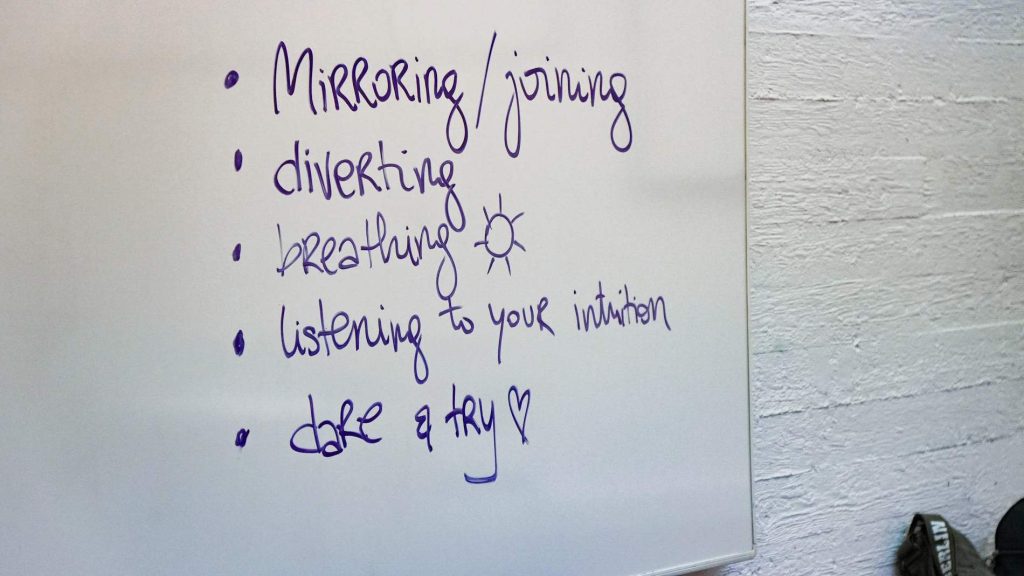
© Sairaalaklovnit
The Pallapupas clown artists and project managers utilised a range of tools to comprehend the needs of their target groups and assess the impact of their work.
In the initial stages of the project, they employed a participatory learning tool known as Art Voices. This tool, alongside various other inspirations, played a crucial role in shaping Diana and Marc’s specific approach to engaging with autistic children.
It also contributed to the information gathered in the Baseline Study (accessible here), conducted at the project’s outset to understand the needs of the ClowNexus target groups before commencing visits.
Additional tools employed to gather information on needs and impact included post-visit reports, feedback forms, direct observation, and surveys involving staff.
Children with ASD – For the children they visited, Diana and Marc introduced an element of surprise to the hospital environment. Their sole agenda was to explore ways to brighten the children’s stay, depending on the child’s inclination at the time.
The clown artists discovered that their presence had a soothing effect on the children, making it easier for them to engage in upcoming procedures, such as entering the surgery room or undergoing anaesthesia.
In cases where children were hospitalised without impending invasive procedures, Marc and Diana tailored their approaches based on the child’s mood and specific situation. Their invitation to play was always open-ended, allowing for spontaneity.
Hospital staff – The clowns assisted the hospital staff by providing support as required. Their presence frequently served as motivation for children to actively participate in various hospital procedures, such as dressing, wearing slippers or removing shoes, transitioning between rooms, or receiving injections.
In a particular hospital visited in Girona, the nurses sought advice from the clowns based on their experience, seeking insights on how to enhance their interactions with children with Autism Spectrum Disorder (ASD).
Family members – Unlike colleagues in day centres and kindergartens, where direct contact with parents of autistic children is rarely feasible for clown artists, the Catalonian healthcare clowns had the opportunity to engage with family carers of the visited children, as they were often present.
This interaction has always been a part of hospital visits, but it became particularly pronounced with the project’s focus on children with Autism Spectrum Disorder (ASD).
Communication with parents also evolved, allowing the clown artists to ask more direct questions.
With increased openness from the artists, who took the time to discuss their work and collaborate with parents as co-creators, parents became more receptive, also sharing the preferences and aversions of the children.
Clown artists – Marc, having limited experience with autistic children, noticed a significant transformation after participating in ClowNexus.
He developed a heightened sensitivity, becoming more attuned to the information gleaned from people in the child’s environment.
Switching partners for visits necessitated explanations to new collaborators or those unfamiliar with the International Artistic Laboratories, and who hadn’t attended many visits with children with Autism Spectrum Disorder (ASD).
This need for verbalisation enhanced their learning processes.
Diana, too, observed a shift. She can now articulate the reasons behind her choice of tools more effectively.
This, in turn, has led to increased receptivity from medical staff, affording the clown artists more space.
This change was particularly noticeable in one of the visited hospitals.
Healthcare clowning organisation – At Pallapupas, there has been a significant emphasis on sustaining the reflective practice and co-creation facilitated by ClowNexus.
Through Marc and Diana collaborating with other clowns in duos and sharing their insights, the benefits of their exploration have permeated throughout the organisation.
Additionally, two national meetings were convened for all the organisation’s clown artists, specifically focused on their work with children with Autism Spectrum Disorder (ASD).
ClowNexus not only provided an opportunity for organisation-wide sharing of techniques for working with children with ASD but also contributed to enhancing Pallapupas’ reputation as a healthcare clowning organisation within hospitals.
Since their involvement in ClowNexus, Pallapupas’ clown artists and staff have been sought out by medical professionals for advice on working with children with ASD.
Recognising this as a crucial need for medical staff, Pallapupas has initiated the development of Guidelines for Medical Staff about ASD.
Presently, the challenge for the organisation lies in disseminating its methods and expertise in working with children with ASD to all of its partner hospitals.
Marc and Diana approached their work in hospitals with a notably improvisational style.
In contrast to many other clown artists involved in the project working with children with ASD, they didn’t pre-create play-like scenarios to present to every child during visits.
Instead, they had to be highly attuned to the dynamics observed when arriving to visit a particular child on a given day, carefully selecting from their toolkit what would best suit the situations encountered.
They engaged in activities such as accompanying without direct contact, mirroring, movement, slapstick, playing with objects, and managing proximity and use of space.
Addressing critical situations observed in hospitals or overcoming resistance were common challenges for the Catalonian clowns, requiring them to find graceful exits and innovative approaches.
Scenario in Focus: Mirroring to overcome resistance
Why interesting: In hospital settings, where both children and their carers contend with varying degrees of distress, numerous potential tensions and obstacles may arise.
Even a simple task, such as a child complying with a carer’s request to prepare for a procedure or leave a certain area, can become challenging.
However, in situations where parents and nurses may face significant struggles, clowns can transform these moments into playful experiences.
This narrative unfolds the use of a particular tool in practice within hospital settings.
Intention: To overcome resistance, encourage collaboration, lighten the mood, and offer relief.
Who participates: Clowns, children, carers, hospital carers if around
Duration: As needed – in the examples provided it took about 15 minutes
Setup of the space: Can be anywhere, this case was the box before the operating room and a hospital ward.
Artistic skills needed: Mirroring, listening, feeling, movement
Props: None needed
Description: The situation described involves a clown interaction with a young autistic boy, approximately 7 years old, who was scheduled for an operation.
The clowns were informed that the child did not want their presence, a sentiment later confirmed by the mother.
The child fixated on a phone, cooperated with the necessary procedures upon entering the operation area, and the clowns respected his space.
However, after awakening from the operation, the child had a tantrum, throwing himself to the ground and resisting efforts to put on his shoes for departure.
Marc, present at the time, approached the situation with utmost care. From a distance, he began mirroring the boy’s movements, incorporating his own subtle game with a handkerchief.
Through this approach, he successfully approached the child, who ceased resisting and assisted him with his shoes.
The clown then provided comfort to the visibly distressed mother, offering a reassuring hug.
At that point, both the child and the mother were able to leave the room and head home.
Ask nothing and you will be rewarded – The appeal of the clowns lies in their lack of a predefined agenda with the children, as discovered by Diana and Marc.
The Catalonian clowns excelled in indirect engagement, avoiding intentional efforts to establish a connection or pressure a child to react, instead opting to play confidently and comfortably alongside them.
This approach proved more effective in duo situations, where the clowns could interact with each other, enhancing the mirroring game.
For instance, the clowns encountered an autistic child in a hospital ward, engrossed in his phone and indifferent to their presence, fixated on videos of people eating.
After this observation, the clowns improvised by “eating” a toy they had, gradually piquing the child’s interest without direct contact.
Eventually, the child directed full attention to the clowns and even held onto one of them to prevent them from leaving.
In another instance, it took three visits for the clowns to engage an autistic girl in drawing during their play sessions.
Balancing humility with confidence – The Spanish clowns’ distinct care in their approach to children, characterised by their restraint, humility, and heightened efforts to observe and listen without overstepping with their energy levels, proved highly effective in establishing connections, particularly with autistic children in hospital settings.
Concurrently, they discovered that there were instances where they could exhibit more confidence in the games they developed.
© Lisa Baxter
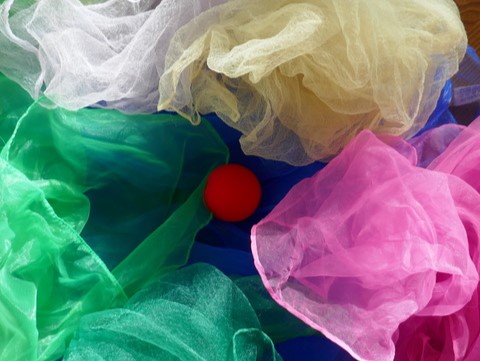
Barbara Asperger and Marie Miklau are healthcare clowns affiliated with ROTE NASEN in Austria, collaborating with ROTE NASEN regional offices in Vienna and Salzburg.
Despite hailing from different regions, this dynamic duo has successfully worked together on numerous occasions.
In addition to her role as a clown, Barbara is a music therapist, incorporating various sound-emitting objects into her therapeutic and clowning practices. Even before ClowNexus, she amassed considerable experience working with children with Autism Spectrum Disorder (ASD).
While Marie had some experience with autistic children during hospital visits, her focus on this demographic was not explicit, and she lacked specific knowledge.
Joining the project at short notice and missing the initial kick-off meeting, she quickly caught up by delving into literature about autistic individuals.
The International Artistic Laboratories also provided her with valuable insights, emphasizing the importance of being attuned to the abilities and social inclinations of autistic children.
ROTE NASEN and healthcare clowns in Austria had previously engaged with children with disabilities through various formats like the Traveling Caravan Orchestra (CarO).
However, they lacked specific approaches for working with autistic children. The clown artists initially sought opportunities to visit children with ASD, soliciting suggestions for new partnerships.
This approach yielded numerous leads, with the Austrian duo ultimately visiting four different places during ClowNexus, namely:
ROTE NASEN Austria aimed to leverage the insights gained from ClowNexus, particularly through the International Artistic Laboratories.
To disseminate these learnings, they implemented various measures, including involving clowns from different regions.
These clowns, when partnering with others in their region, shared their acquired approaches and lessons learned in the co-creation and exploration process.
Another measure involved participating clowns conducting workshops for “multipliers” from different regions where ROTE NASEN operates. These multipliers could then disseminate the learnings and insights to regional offices and clowns working in their respective areas.
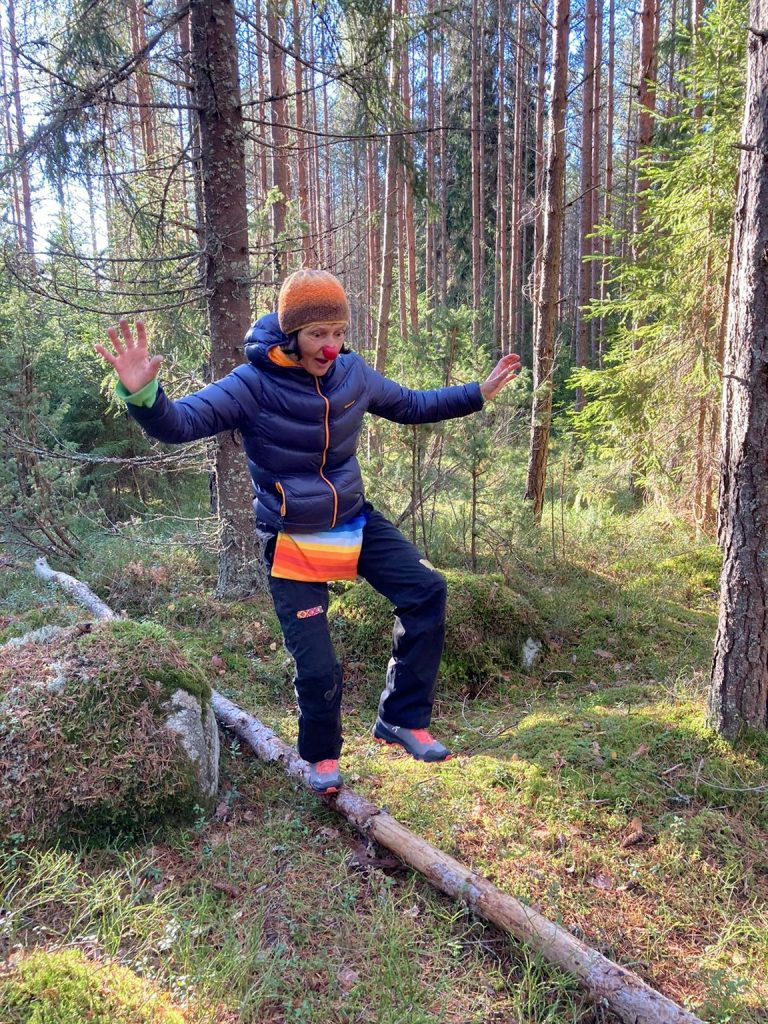
© Sairaalaklovnit
The Austrian organisation and participating clown artists employed a range of tools to identify needs, reflect on impact, and extract lessons from their visits.
In the Baseline study (accessible here), conducted early in the project, the then research manager at ROTE NASEN Austria utilised the Art Voices technique to understand the needs of children with ASD.
Additionally, they employed visit observation checklists and post-visit forms completed by the clowns.
Marie and Barbara approached their work methodically, engaging in numerous discussions and meticulously documenting their findings.
Their overarching strategy revolved around leveraging their individual strengths.
Marie’s clown character was more inquisitive and exaggerated, while Barbara, being a therapist as well, incorporated self-awareness to observe the children’s reactions.
Barbara’s background proved invaluable as she contributed numerous ideas for experimentation, allowing the duo to discern what worked well and what didn’t. She was adept at reading children’s reactions.
The ensuing summary outlines the impact of the Austrian clown duo’s work with children with ASD on various stakeholder groups in the project.
Children: The Austrian clown artists regularly visited a diverse group of children, and feedback from a therapist whose groups they engaged with highlighted the significant positive impact on the children’s emotional development.
The clowns’ ability to express a wide range of emotions complemented the work done in emotions classes, where children are encouraged to do the same.
Results from a small research study conducted in Austria revealed that teachers and institutional staff identified several crucial impacts of clowning on the children.
They observed the establishment of meaningful relationships, the clowns contributing to pedagogical or therapeutic objectives, and the children/young adults being empowered to actively participate in group activities.
Parents/carers: The Austrian clowns only had direct contact with a parent during visits to a family consisting of a mother and four children.
A challenging aspect for the clown artists was that, without the involvement of an institution, organising the logistics of a visit became complicated. Due to the mother’s busy schedule, visits were often cancelled on short notice. However, when visits did take place, the experience was immensely positive for all parties involved, including the children, clowns, mother, and sometimes, even neighbours.
Following one particular visit where the mother was present, she expressed her enjoyment to the clown artists. She shared that she relished being with her kids, observing their interactions and playing together. She described the experience as very relaxing, appreciating the lightness and playful atmosphere created by the clowns during the interaction with her and the children.
Teachers & other institutional staff: Teachers and institutional staff completed post-visit forms following most of the clown visits. These forms were subjected to qualitative content analysis, employing inductive categories.
The feedback indicated that the staff enjoyed participating in the clown visits, found the reflection on the children/young adults and their needs with the clowns important, and were inspired by the clowns in developing tools for their work.
One teacher expressed gratitude for the opportunity that clown visits provided for her students to engage in extracurricular activities.
Similar to the experience with the mother in the home visit example, direct contact with clown artists in institutions sometimes faced overload.
The envisioned co-creation in ClowNexus was more feasible during certain periods than others.
Despite this, the clown artists fully integrated the information gathered about the institutional carers’ goals and needs. For instance, in a day centre for children with ASD, the focus was on developing everyday life skills such as greetings and maintaining an appropriate distance. The clowns incorporated these aspects into their interactions with the children.
In a visited school, the clown artists established a close partnership with the teacher, dedicating significant time to discussing and reflecting on each child before and after each session.
They explored new ideas and surprising elements, with Barbara’s background as a therapist contributing significantly to the exchange. This collaborative approach was also evident in the visited therapy groups, where the clowns focused on life skills and emotional development for young boys.
The therapist participating in these groups considered the experience refreshing and expressed a desire for more playful moments with the kids.
The positive impact extended beyond individual visits. The clown artists were subsequently invited to conduct a training workshop for therapists at the institution and to participate in improvisation training for children with ASD, incorporating theatre skills.
Clown artists: The clown artists underwent transformative learning during the ClowNexus project visits. Marie observed a profound impact on her clown persona and her work in various settings, including hospitals.
In her own words, she expressed, “I started to utilise some abilities that I already possessed, but I could now unleash them more and highlight their uniqueness.”
Healthcare clowning organisation: By emphasising the multiplication of learning throughout the organisation, ROTE NASEN seized the opportunity to gain insights into approaches for working with children with ASD and disseminated this knowledge across the various regions where it operates.
The visits coordinated by Marie and Barbara forged new institutional partnerships, some of which endure beyond the project’s conclusion.
The workshops conducted by participating clown artists for their colleagues were further enriched through these partnerships. For instance, the head of the day centre they visited shared expertise with the participants in one of these workshops.
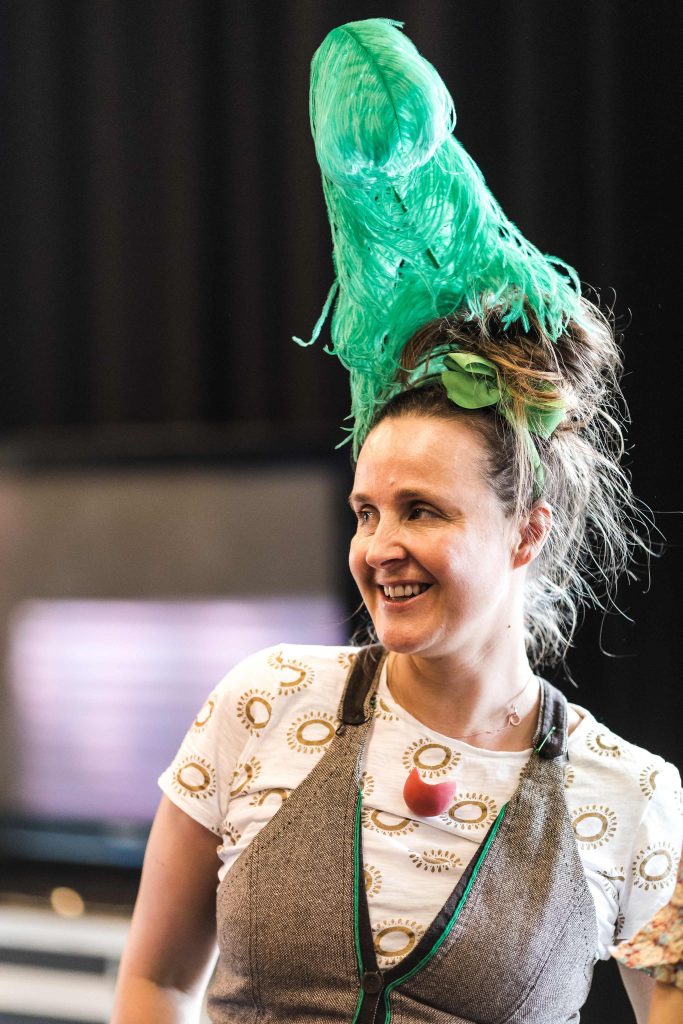
© Saulius Aliukonis
The Austrian clown duo engaged in experimental approaches during their visits to children with ASD, focusing on the senses, emotions, togetherness, and playful exaggeration, including emotional expression.
Among the tools they employed was one described below, where they explored various techniques to enhance children’s self-awareness.
Typically lasting 1.5 to 2 hours, their visits incorporated innovative elements, one of which is highlighted below.
Scenario in focus: Playing Animals
Why interesting: This tool is remarkably simple and accessible for children, offering engaging participation for individuals with varying abilities who can adapt the game to their comfort level.
Intention: The goal is to unify the group by proposing a familiar, inclusive activity that fosters a sense of camaraderie among participants. The clowns effectively shift the focus onto shared experiences, promoting unity among the children.
Who participates: Children, teachers, clowns.
Setup of the space: The visits primarily occurred in institutions, typically outside the classroom. The clown duo experimented with different spatial arrangements, initially performing in front of the groups, later trying to play from the back, and eventually having the children sit in a circle.
Duration: 20-30 minutes
Artistic skills needed: Roleplay, movement, slapstick, senses, use of space.
Props: Two suitcases, one containing small toy animals, the other an instrument.
Description: The clowns bring a suitcase filled with small toy animals, inspired by a teacher’s suggestion that children love animals. They pass around the little animals, embodying each creature and making whimsical sounds.
The clowns exaggerate behaviours typical to the animals, such as a mouse quietly scurrying or a sleeping turtle. This serves as an invitation for the participants to imitate and embody the animals, recognising and mirroring their different traits, emotions, and behaviours.
Participants also have the opportunity to come to the foreground temporarily and request another participant to represent their (favourite) animal.
The spatial arrangement is crucial: The Austrian duo working with children with ASD extensively experimented with different setups during their visits. Performing at the front sometimes excluded children who preferred to stay at the back.
To address this, the clowns started entering from the back, acknowledging the children there before moving to the front. However, the most effective arrangement proved to be having children seated in a circle.
Tailored approaches for different age groups are essential: While working with both younger children and youths, the clowns noticed it’s easier to engage with smaller, more curious children.
For the older group, the clowns sought the assistance of teachers for deas that would resonate with their distinct interests. The clowns’ experience of connecting more easily with younger children than teenagers also holds true for neurotypical children.
The exaggeration characteristic of clowns serves as a valuable learning experience. Marie, one of the participating clown artists, utilises a curious clown character that experiments with expressing very big emotions during visits.
This approach, where she shares her feelings in different situations with the children, teachers, and her duo partner, becomes an opportunity to support the emotional development of the children.
Building relationships over time is essential. As relationships develop, participants tend to become calmer and more engaged in the activities.
The concept of nearness and distance, creating a safe space, is vital. The ability for participants to leave the room when needed or mentally retreat into their own world is important. Personal (1:1) invitations to participate are also valuable.
Empowering individuals to say NO is considered acceptable in this context.
Having a familiar contact person proves helpful for regulating emotions, maintaining focus, and interpreting jokes.